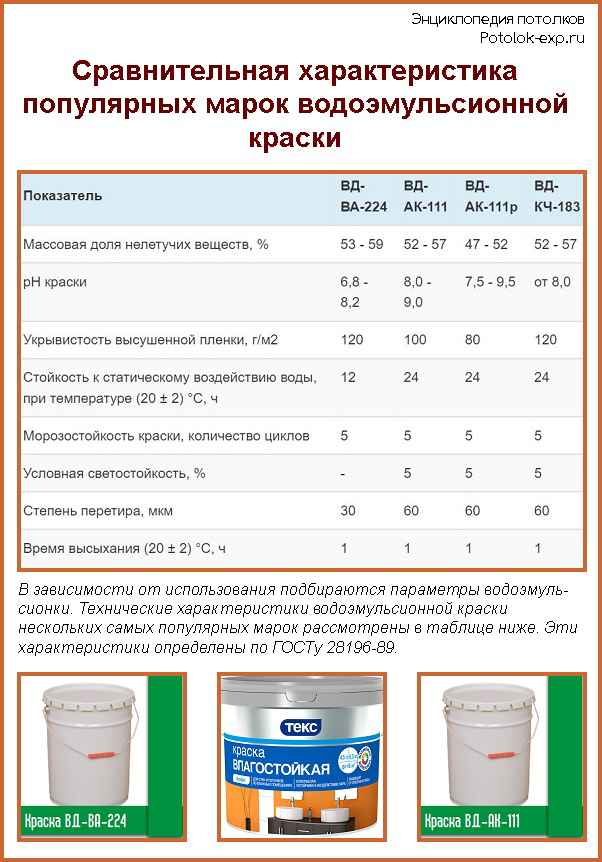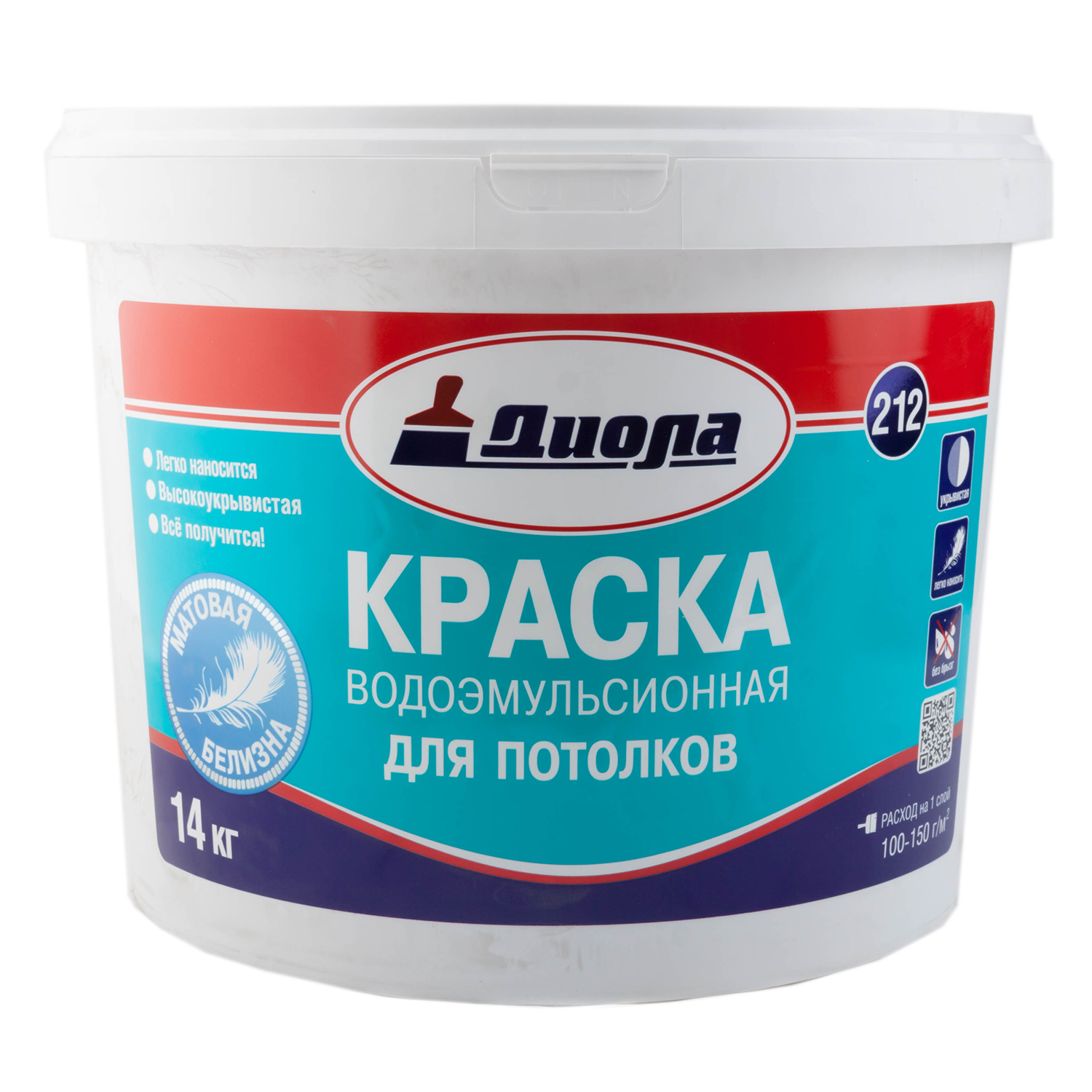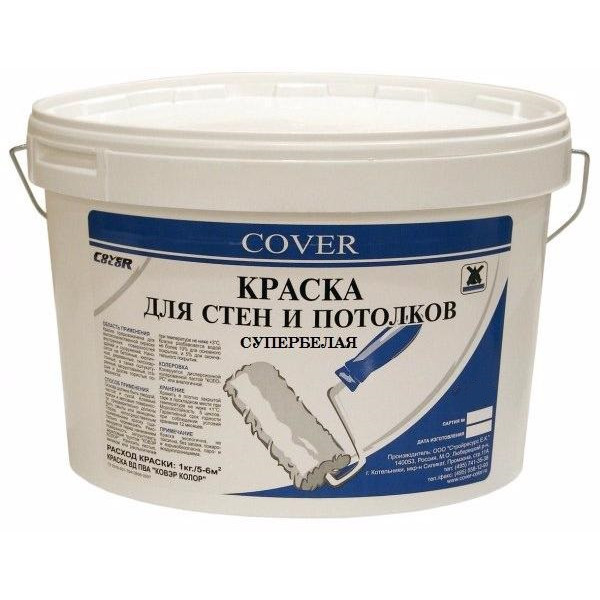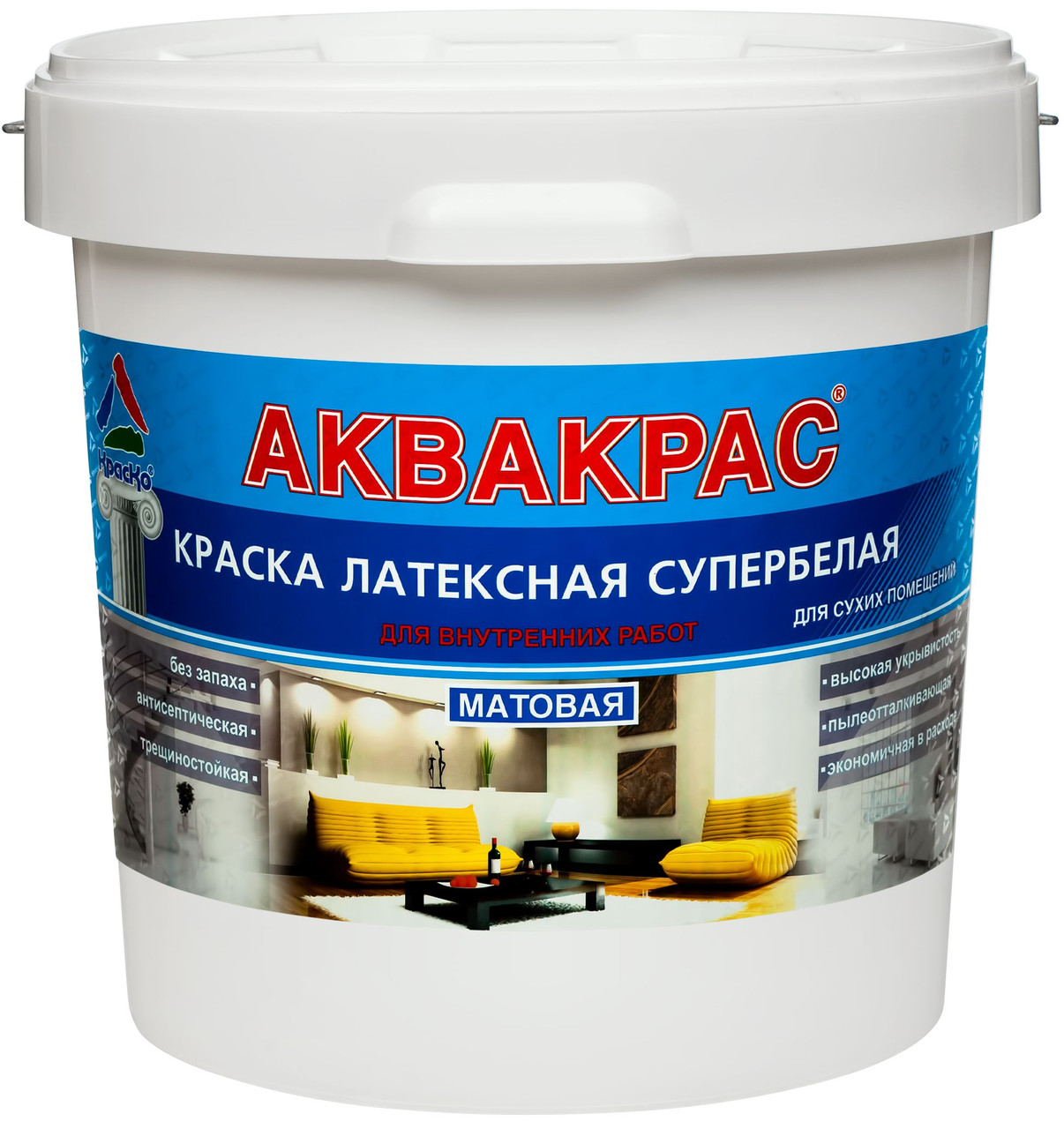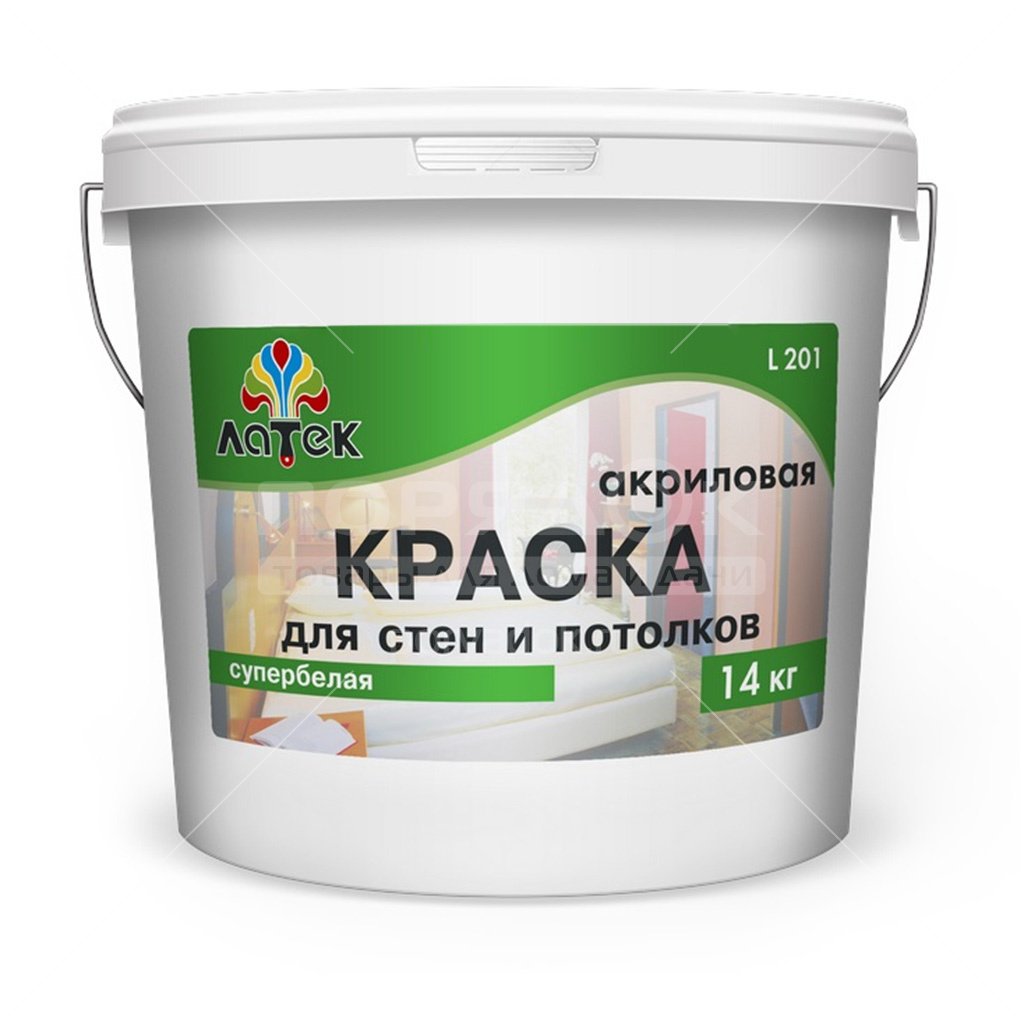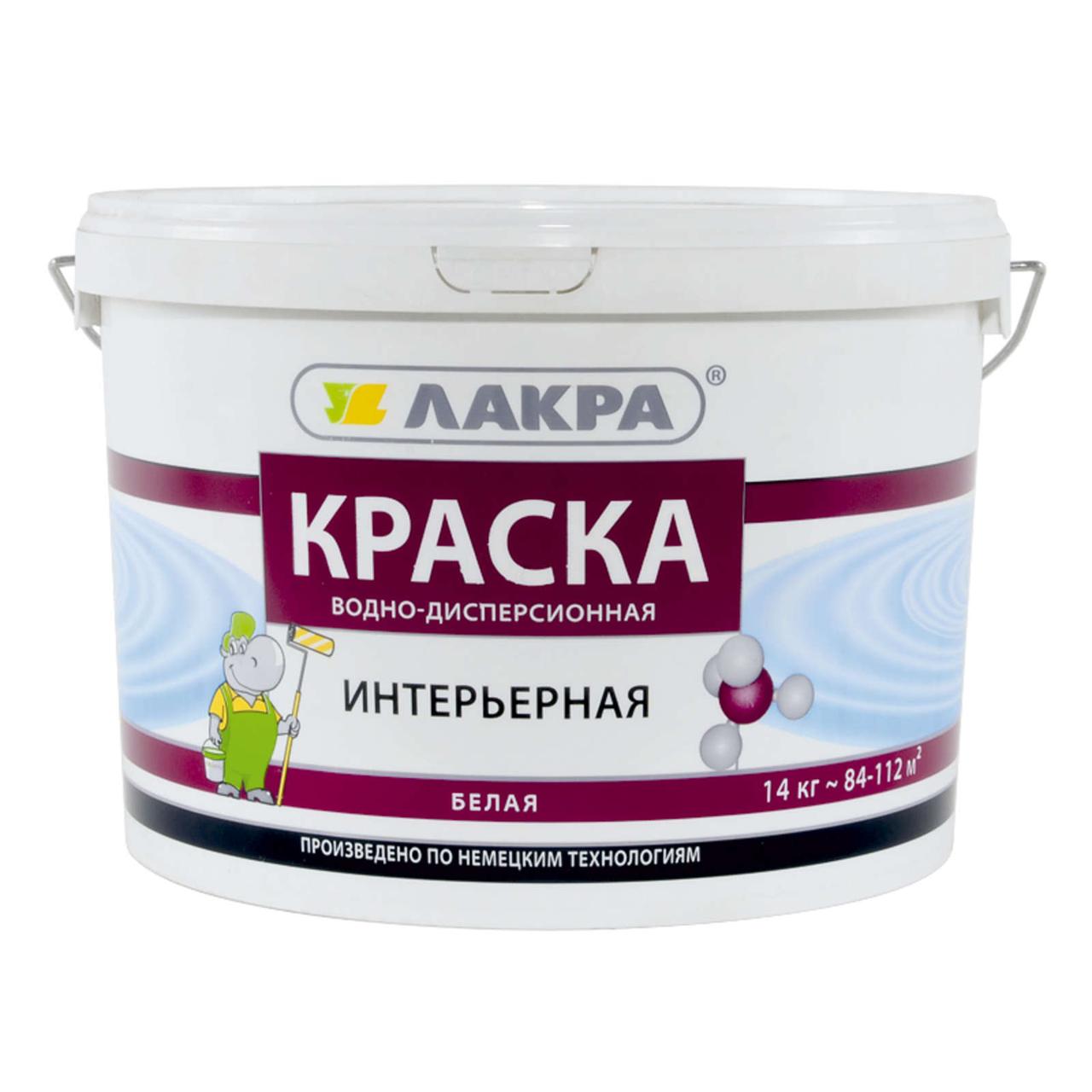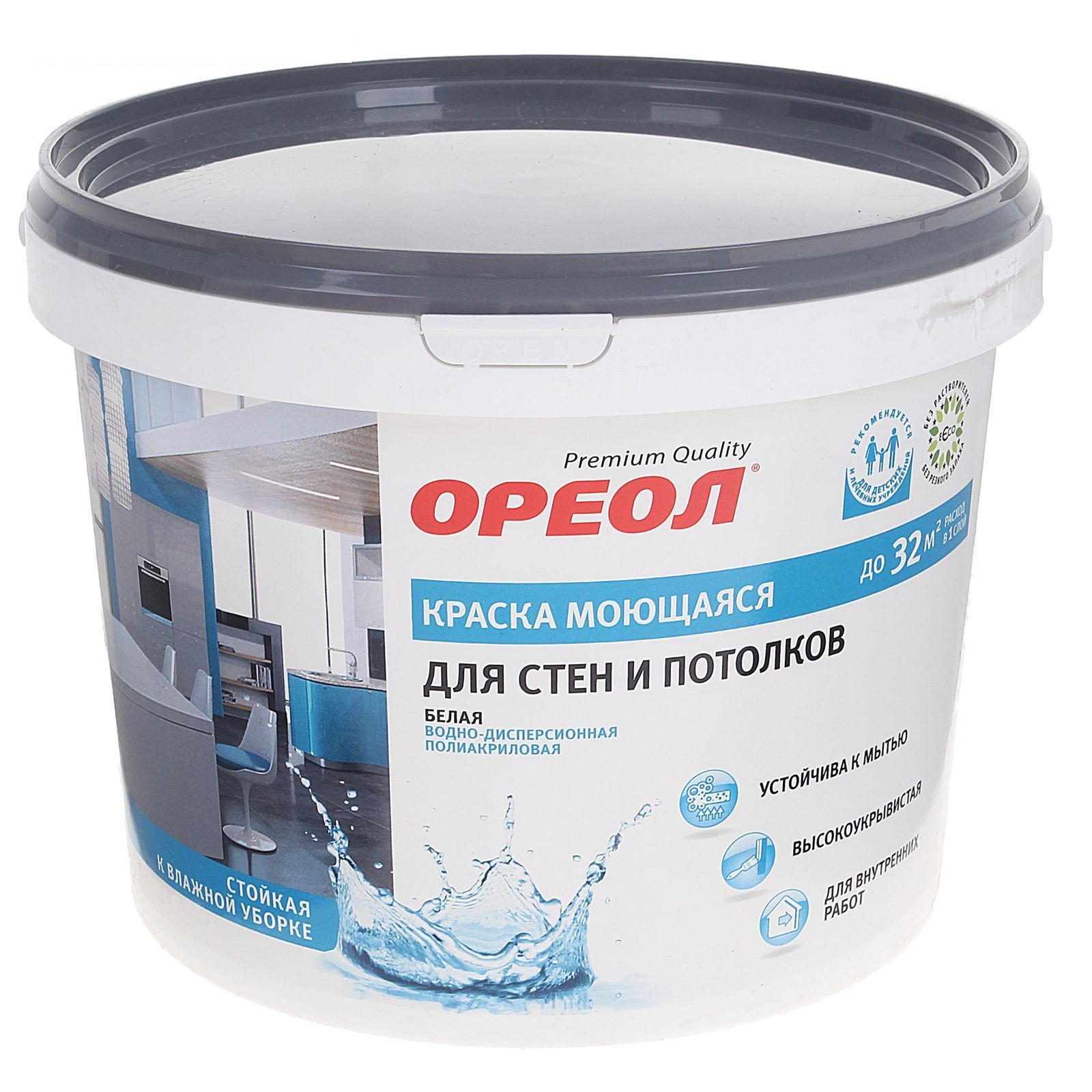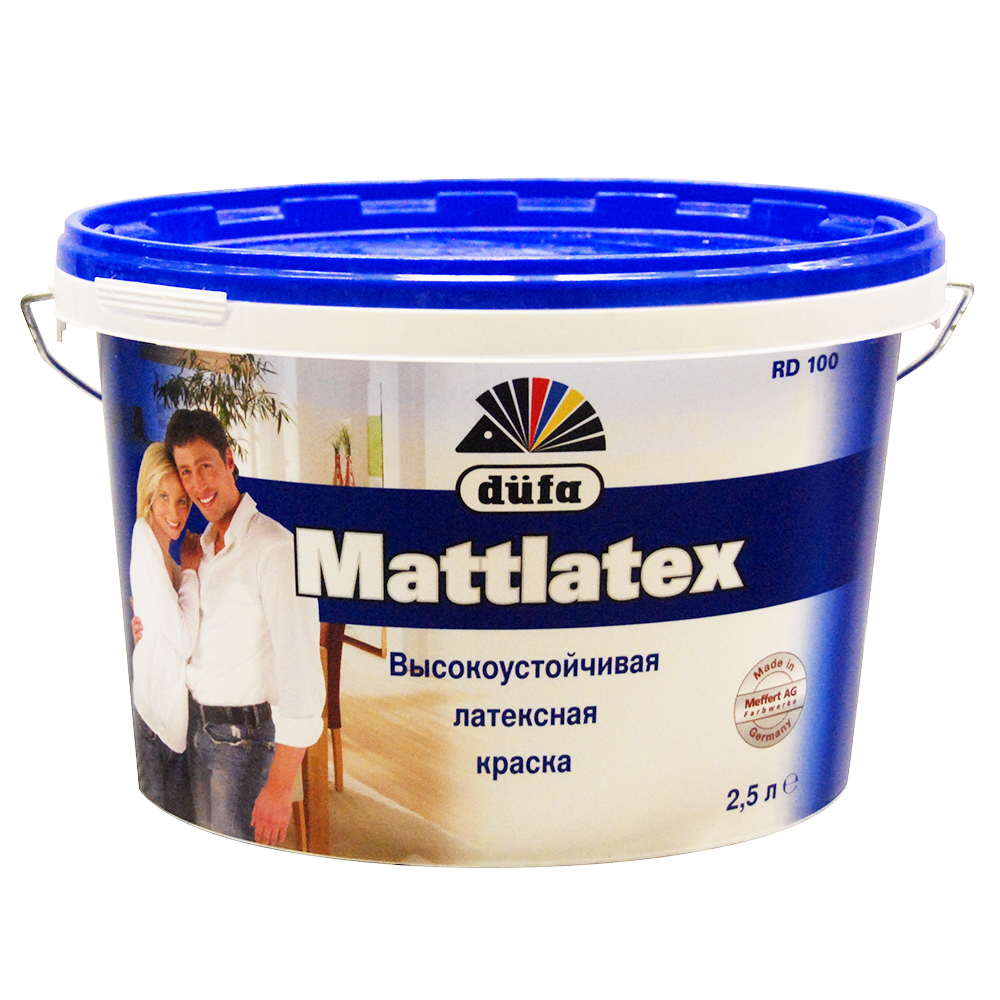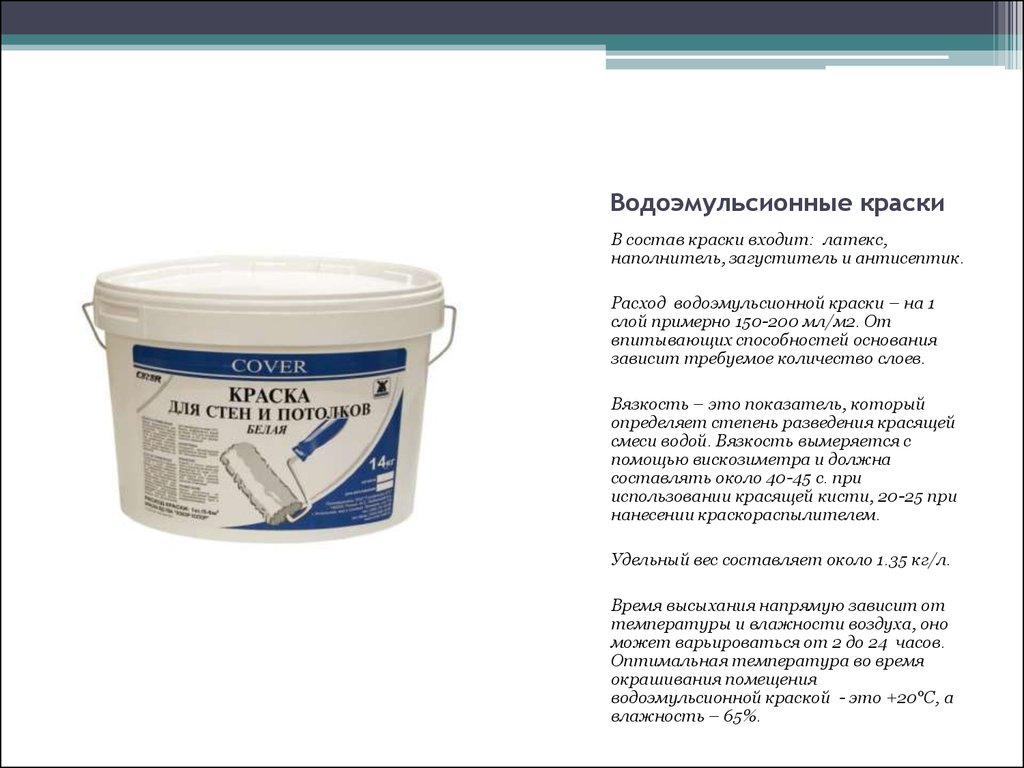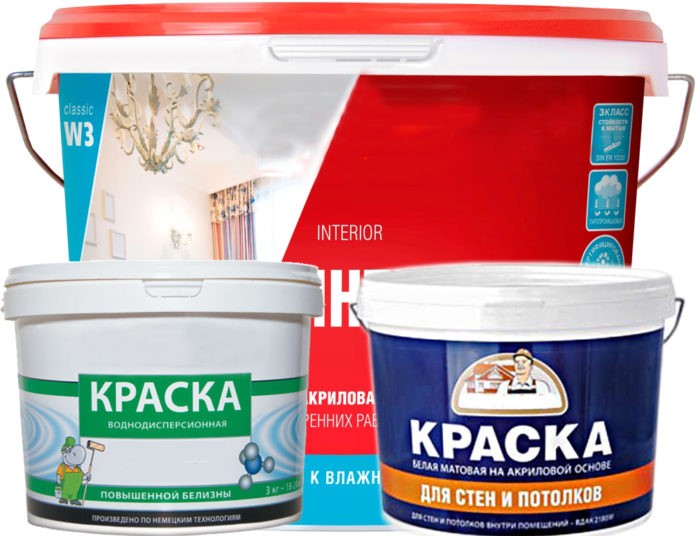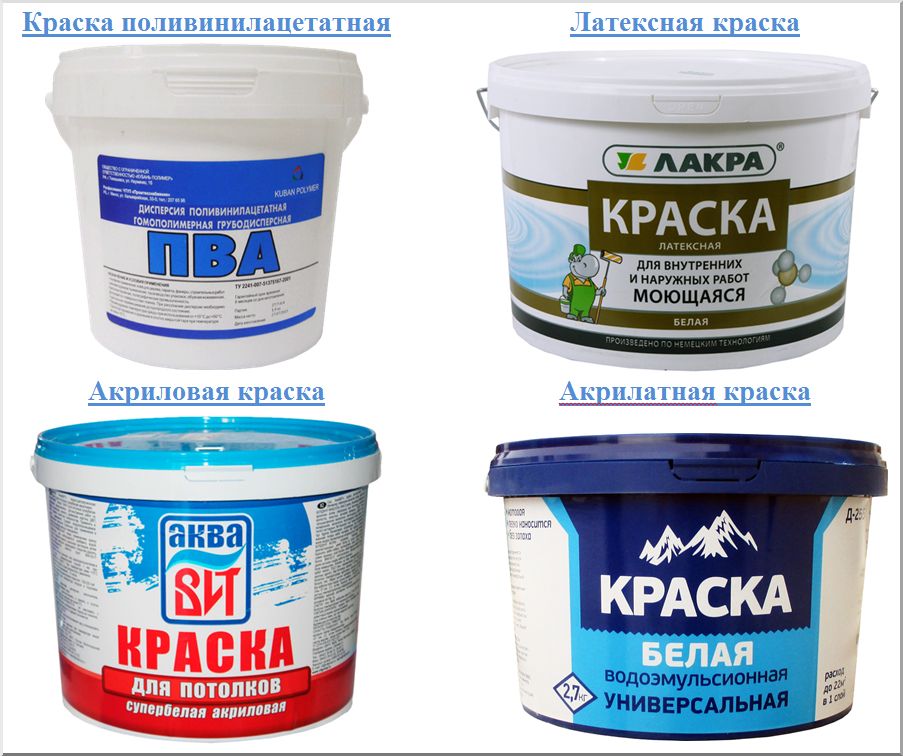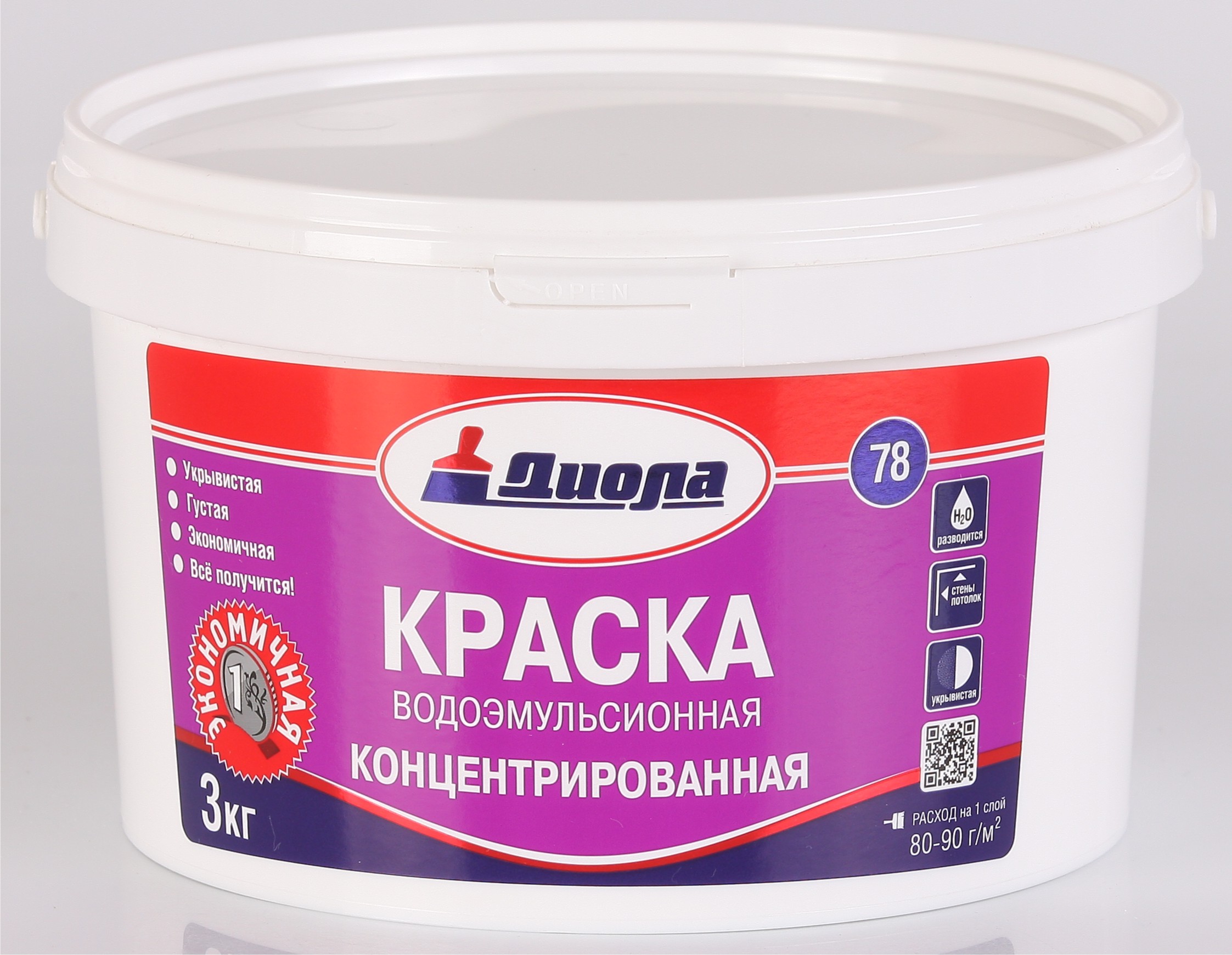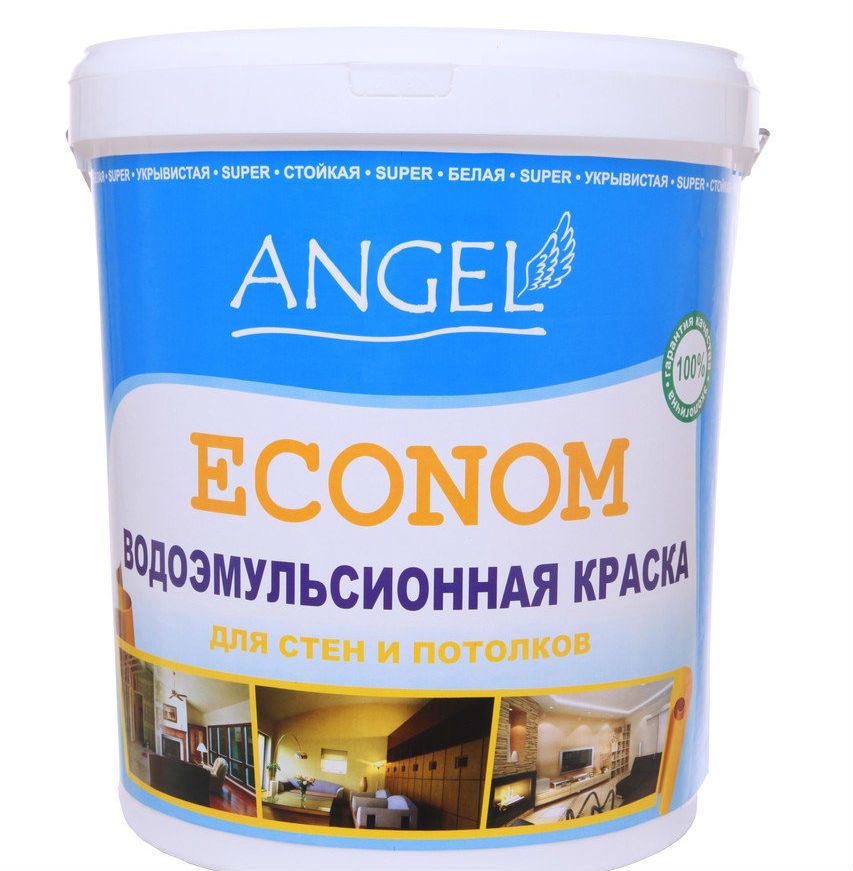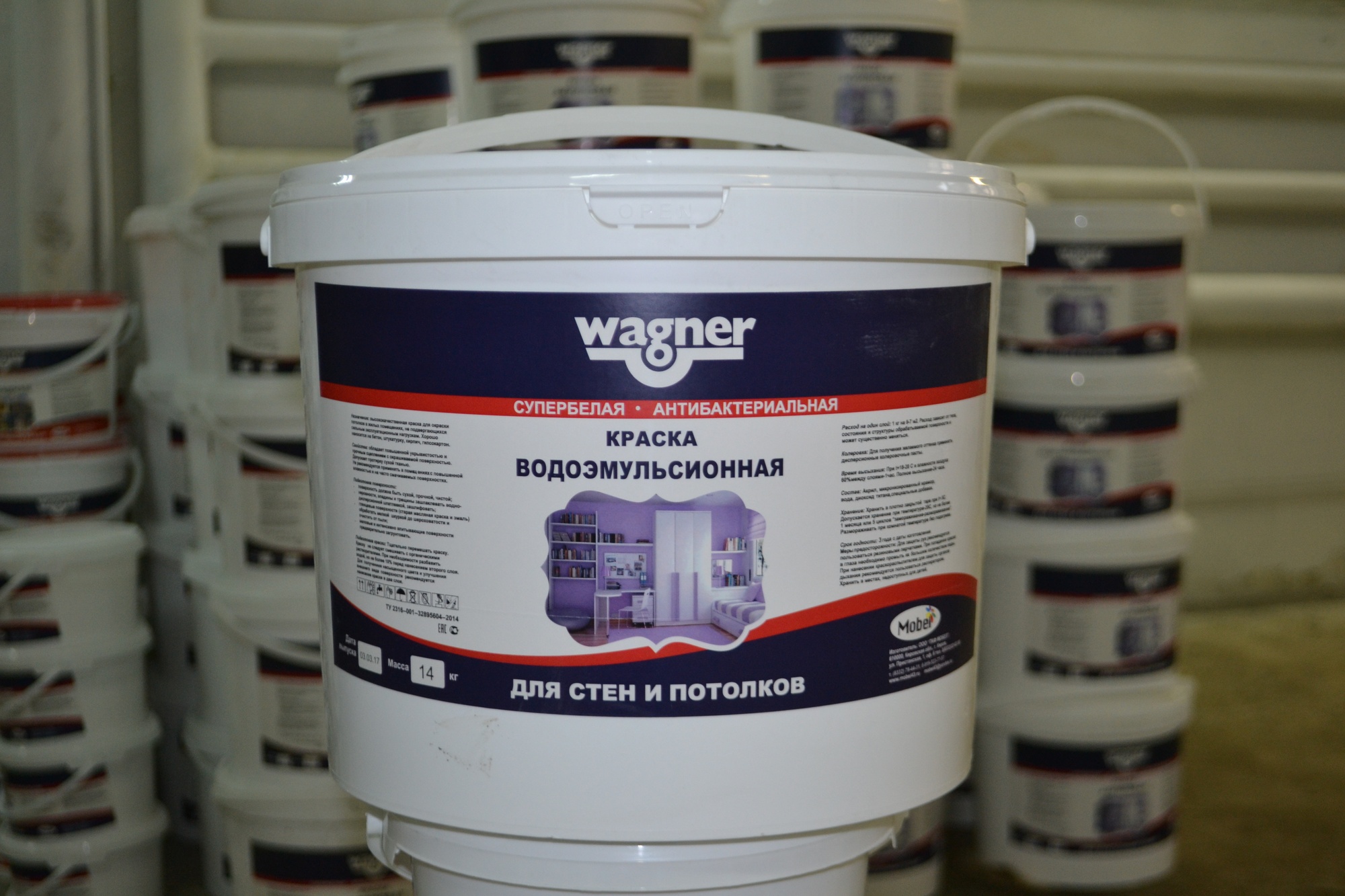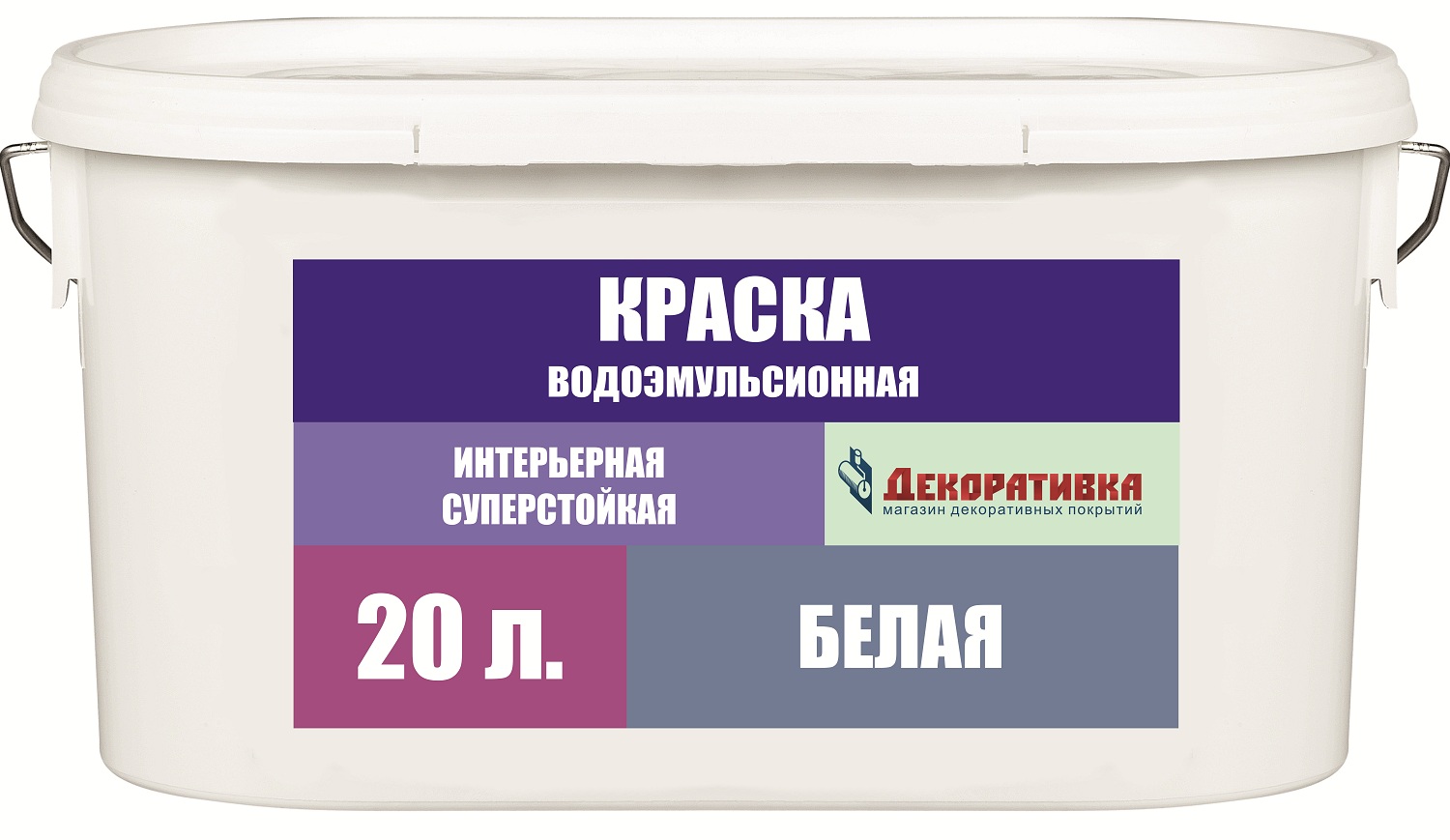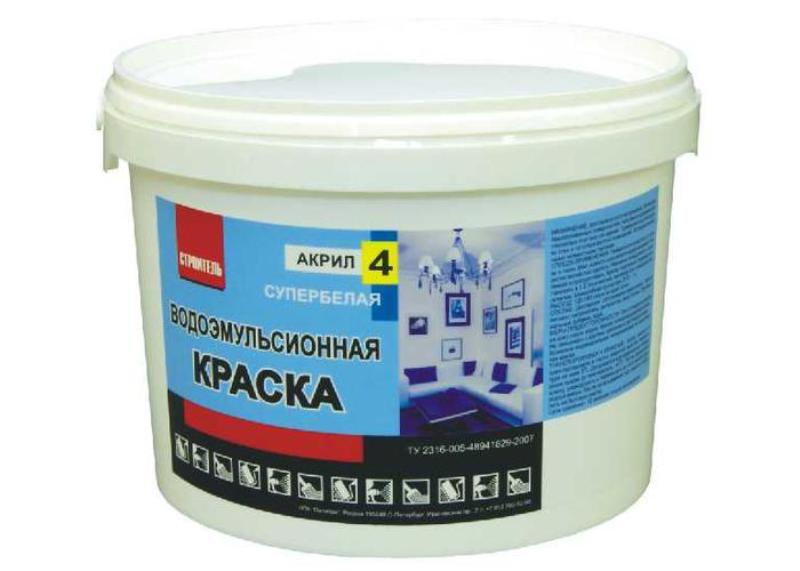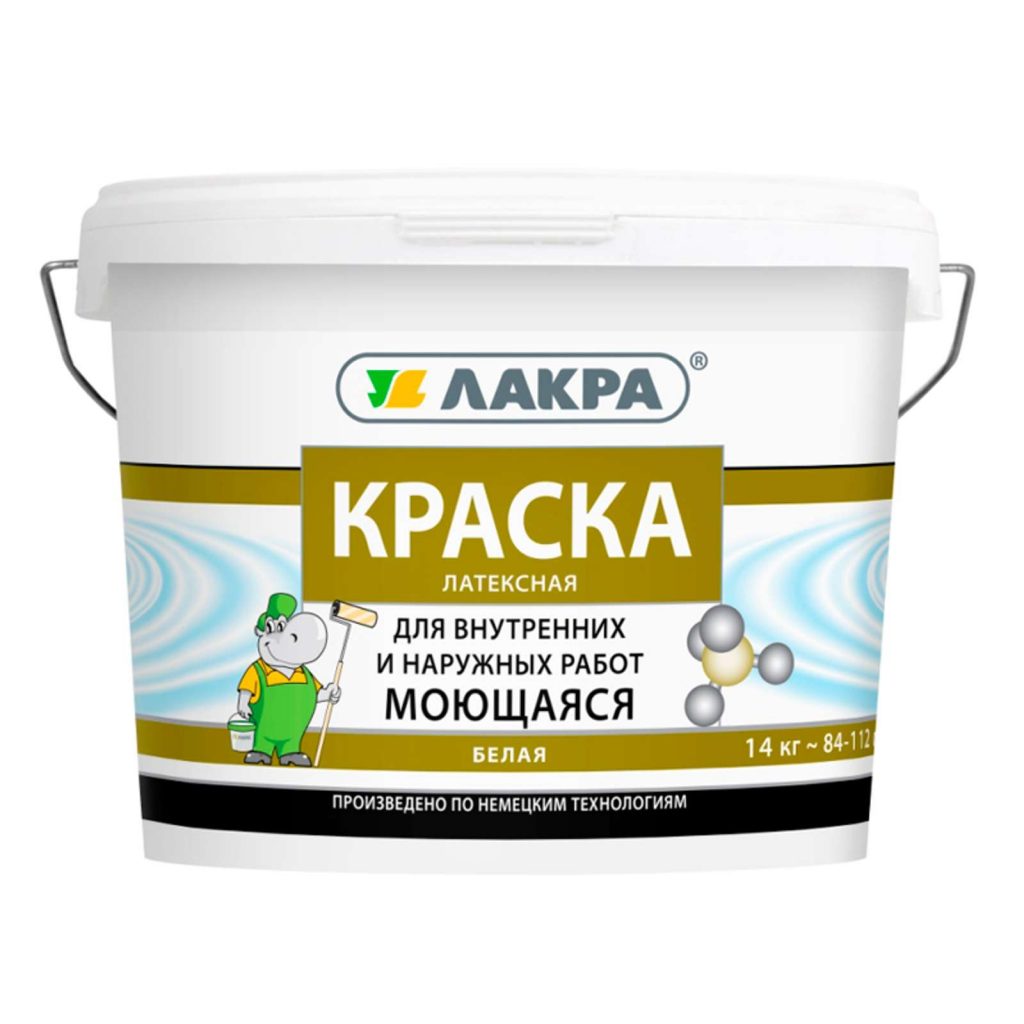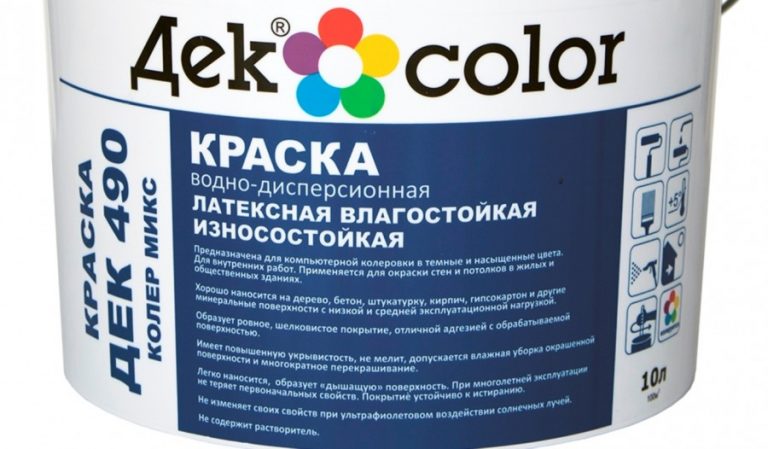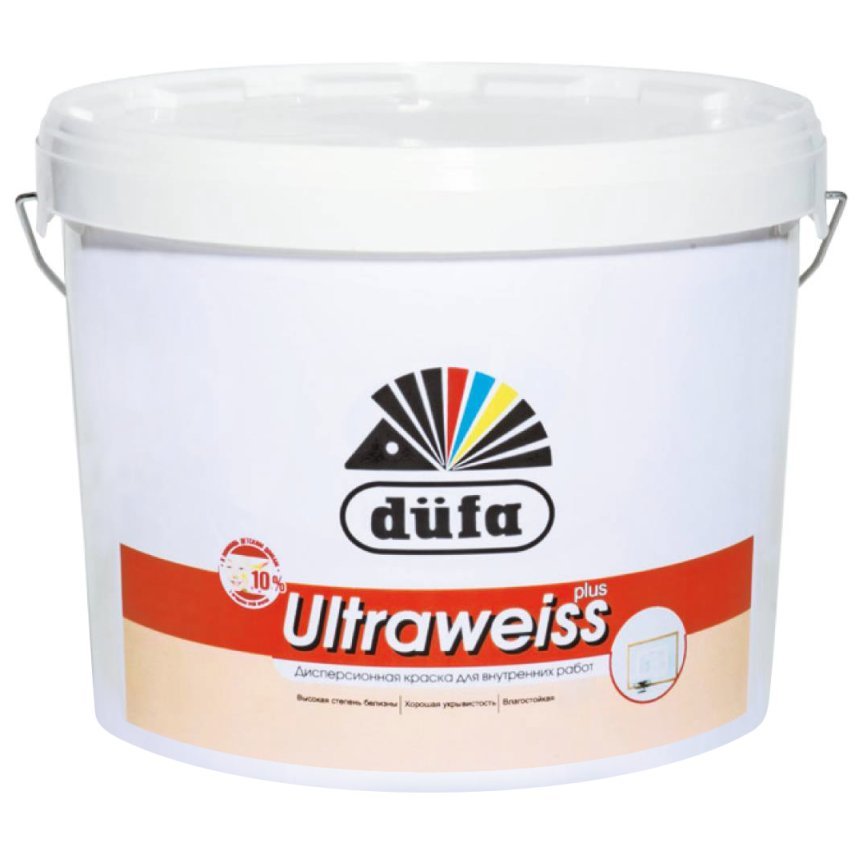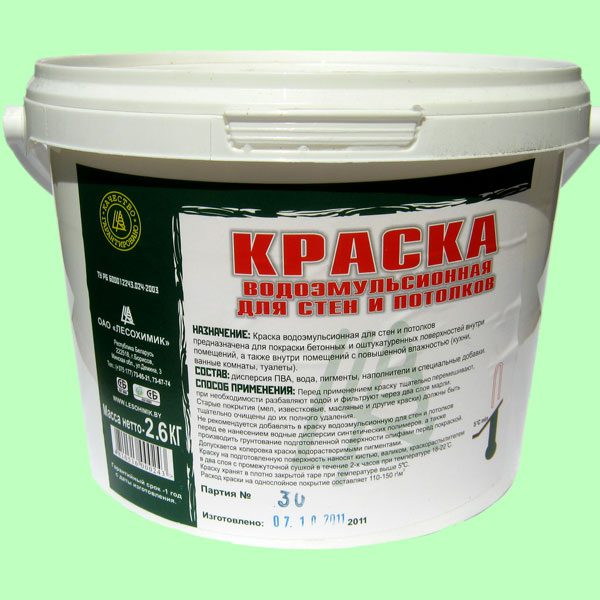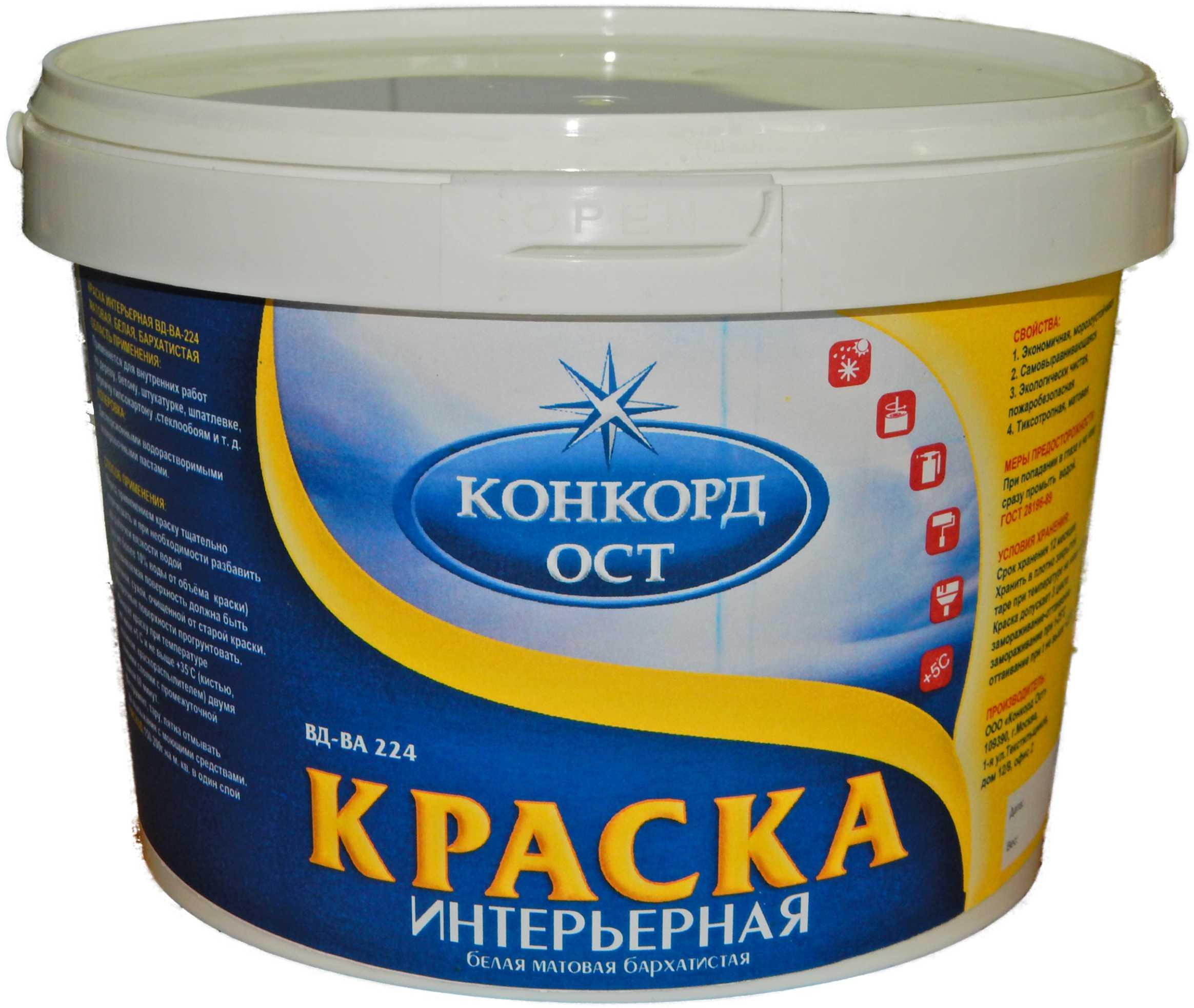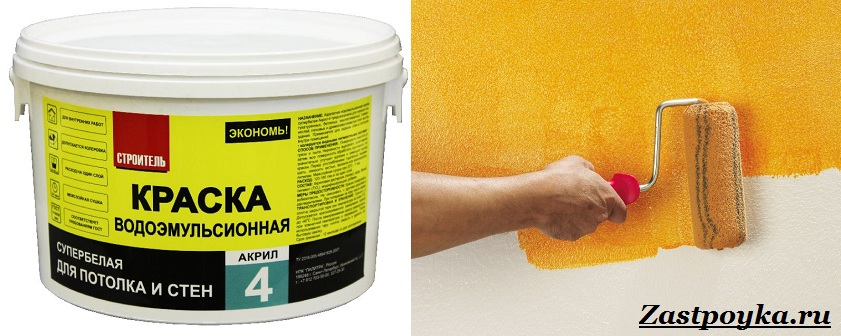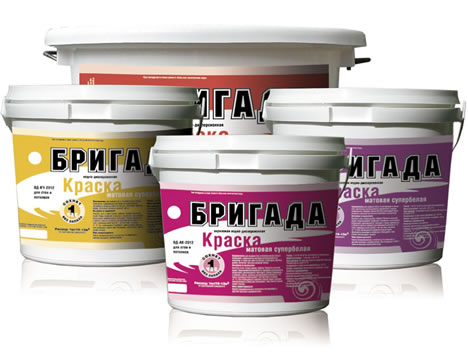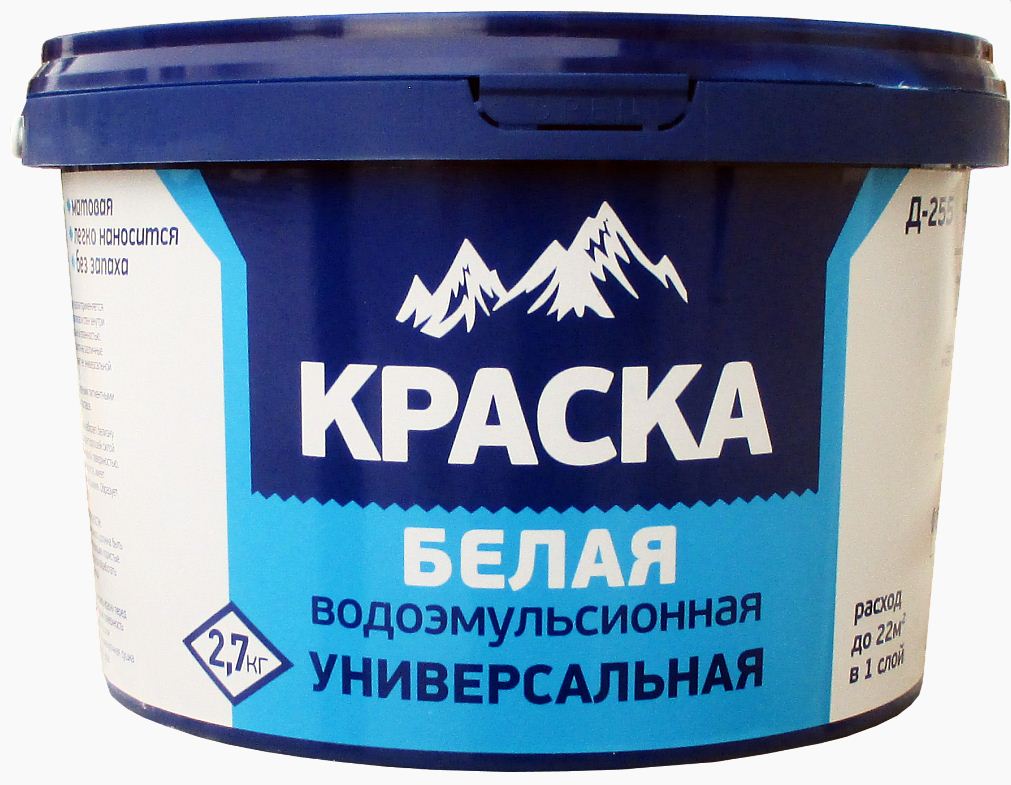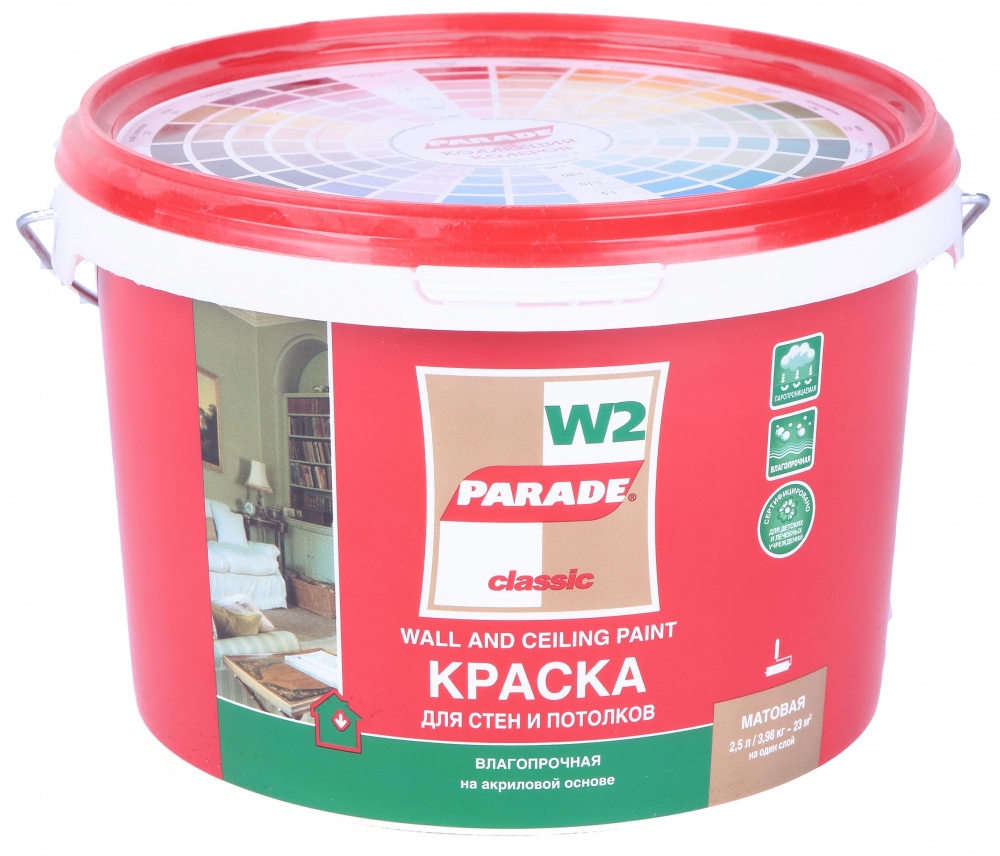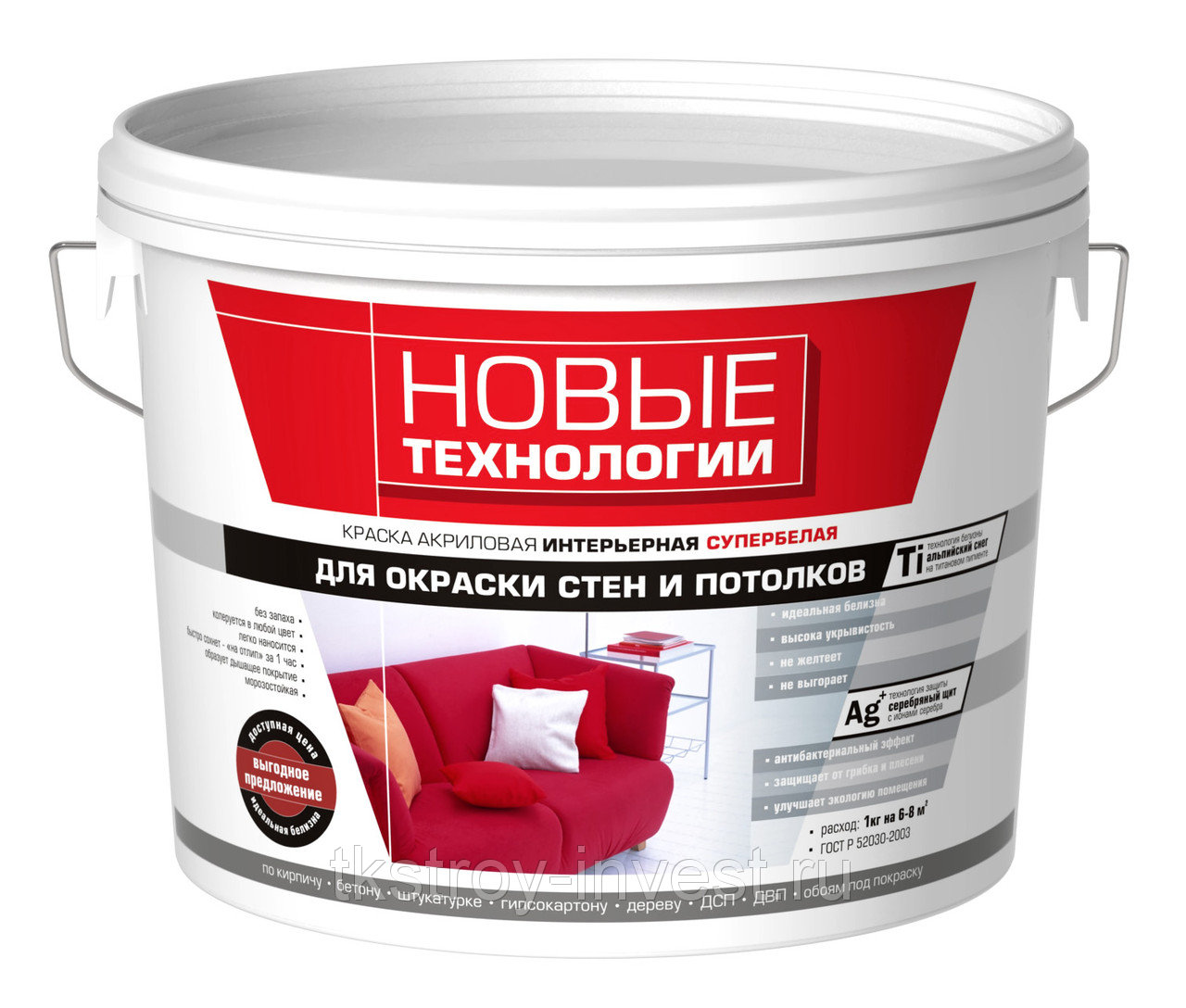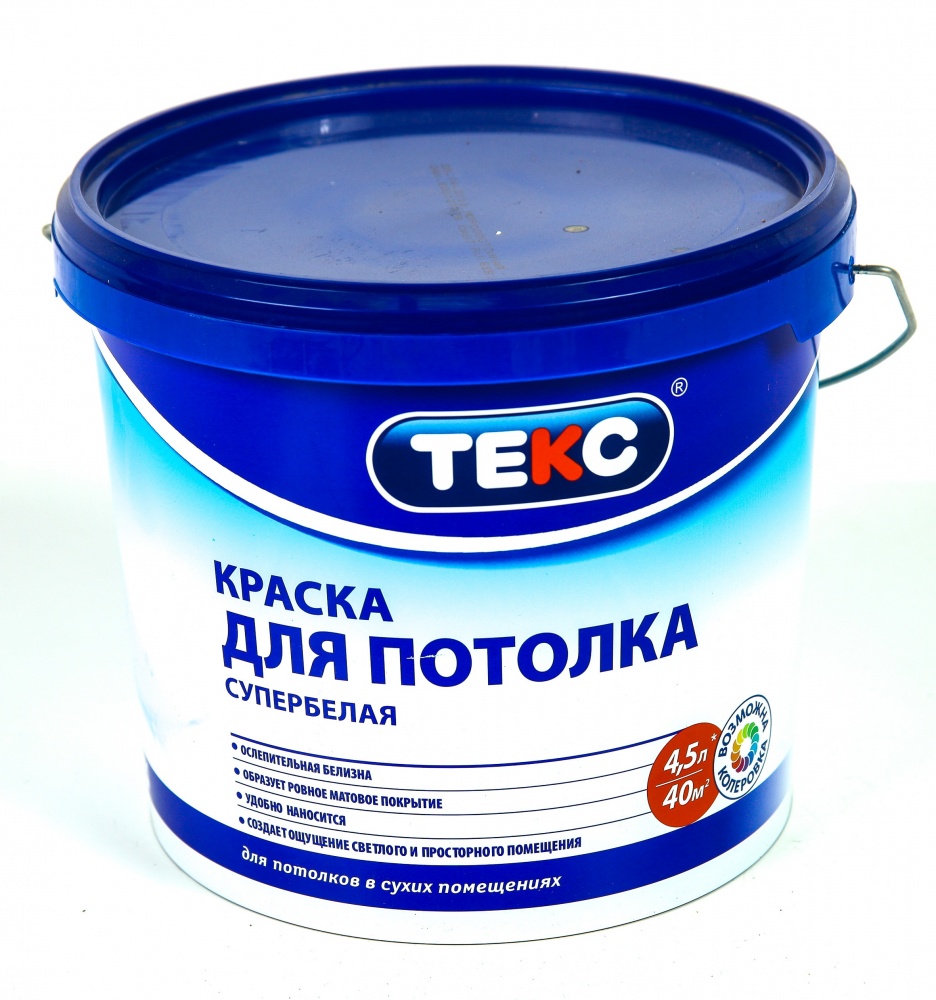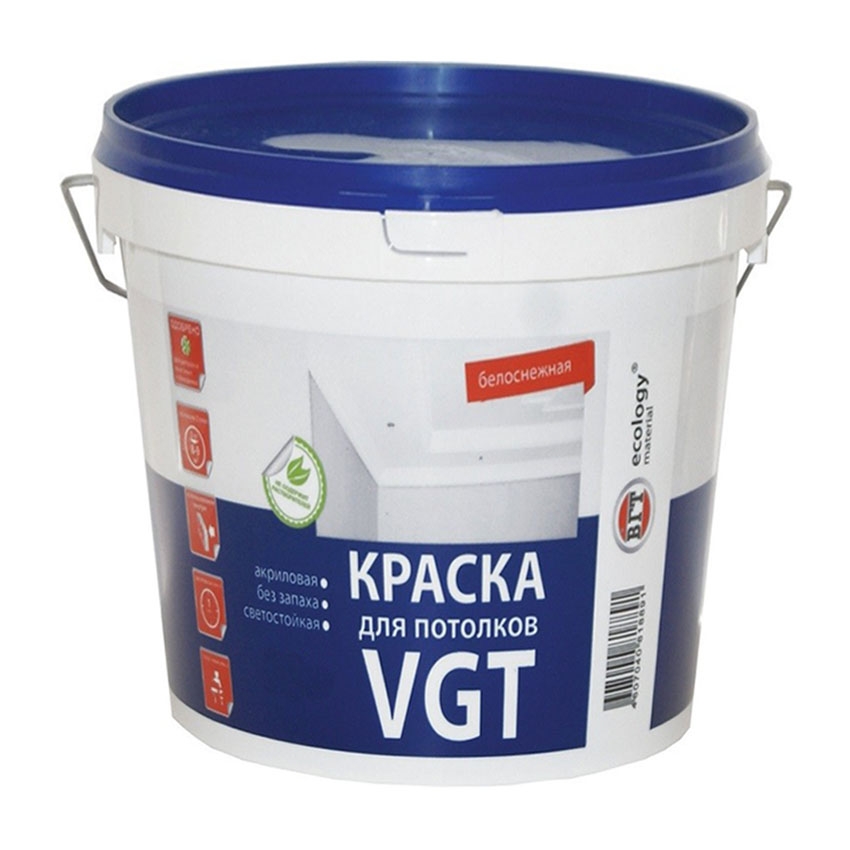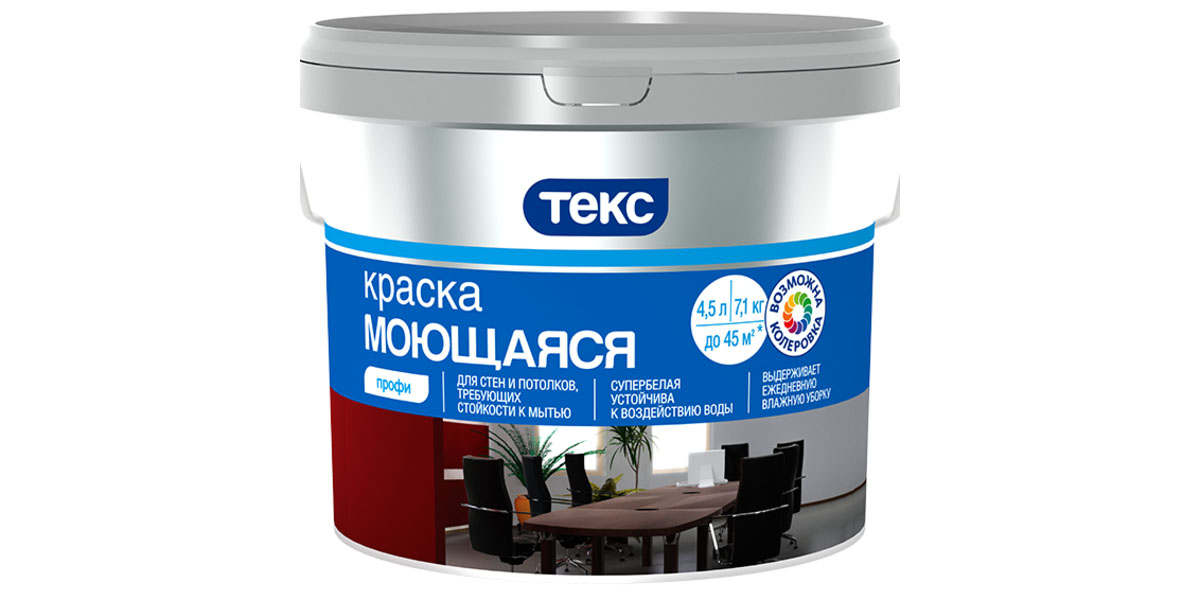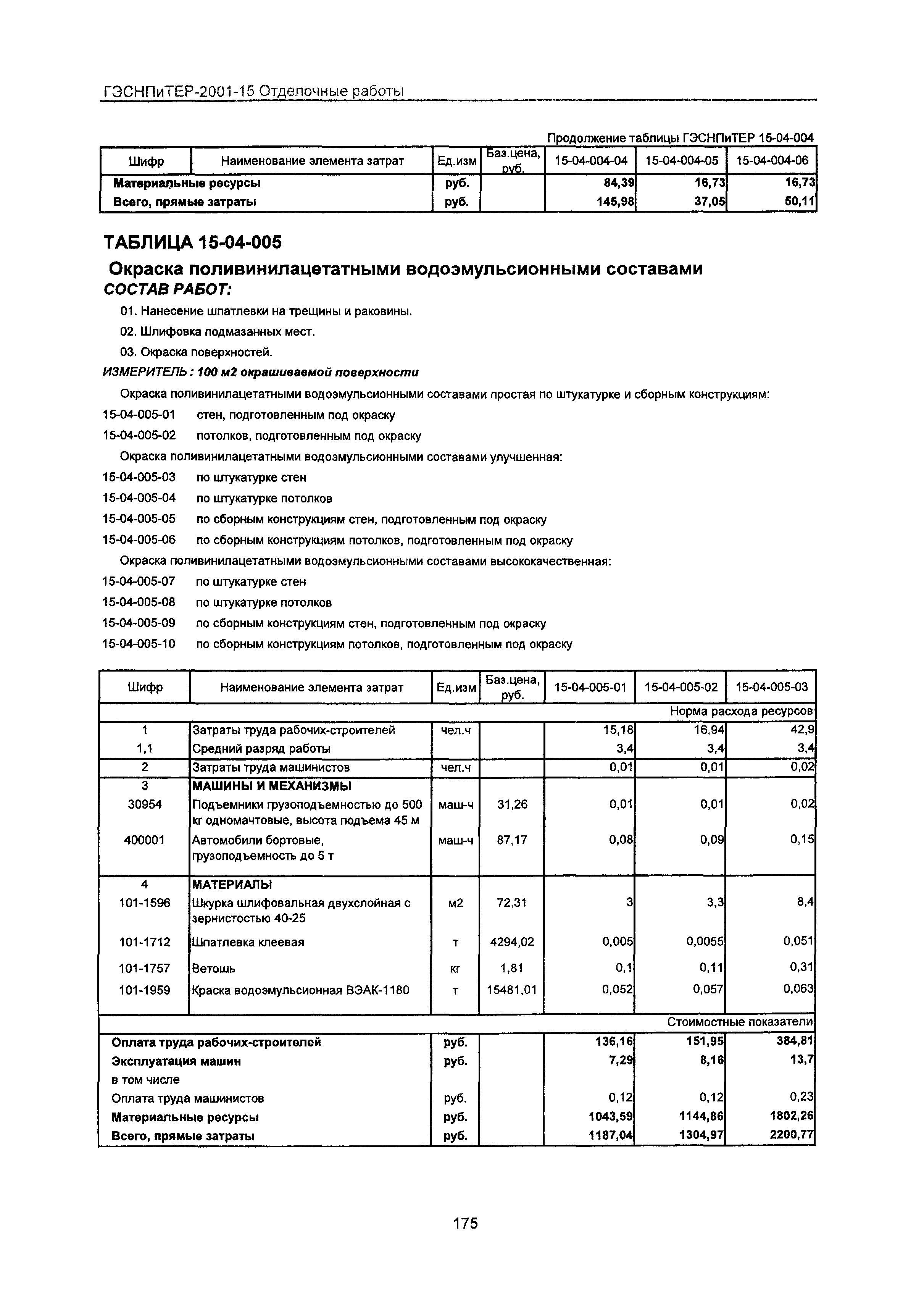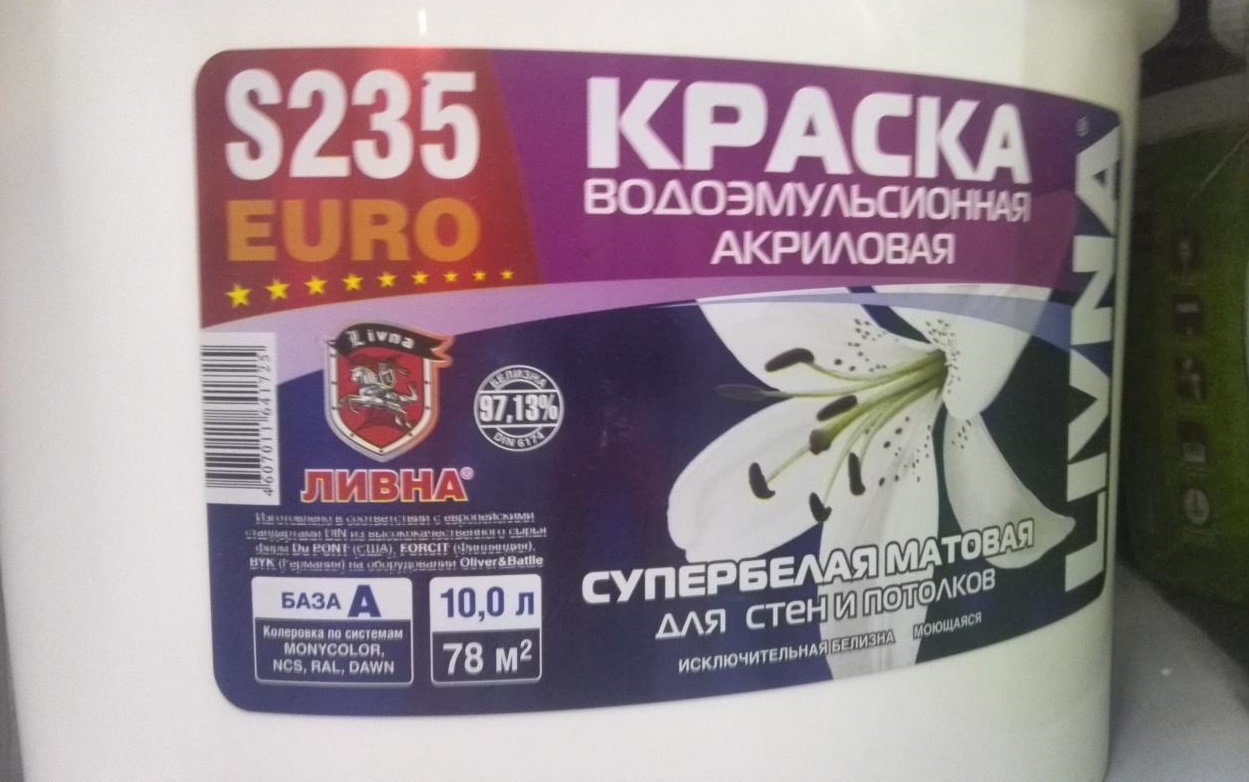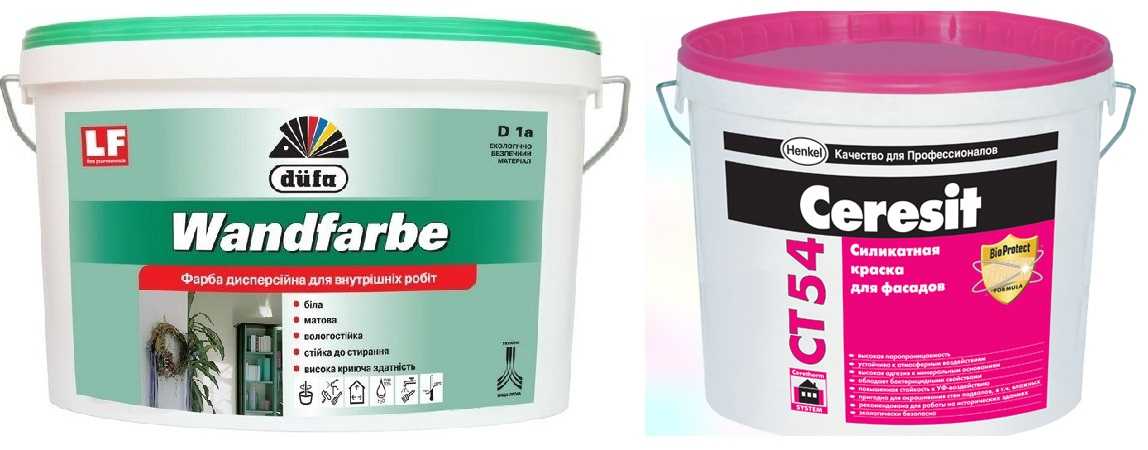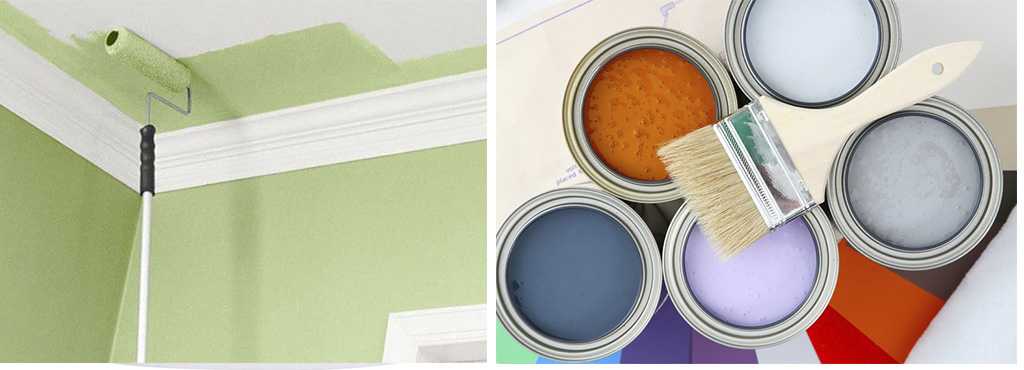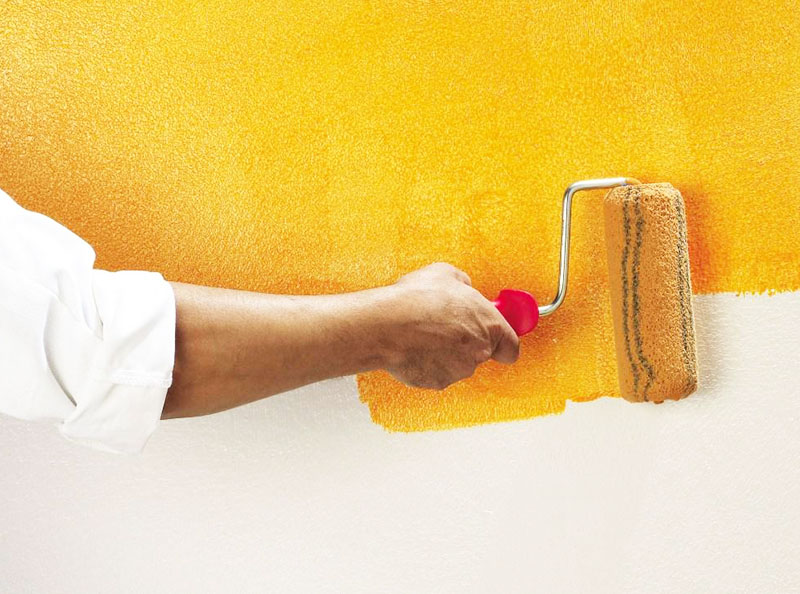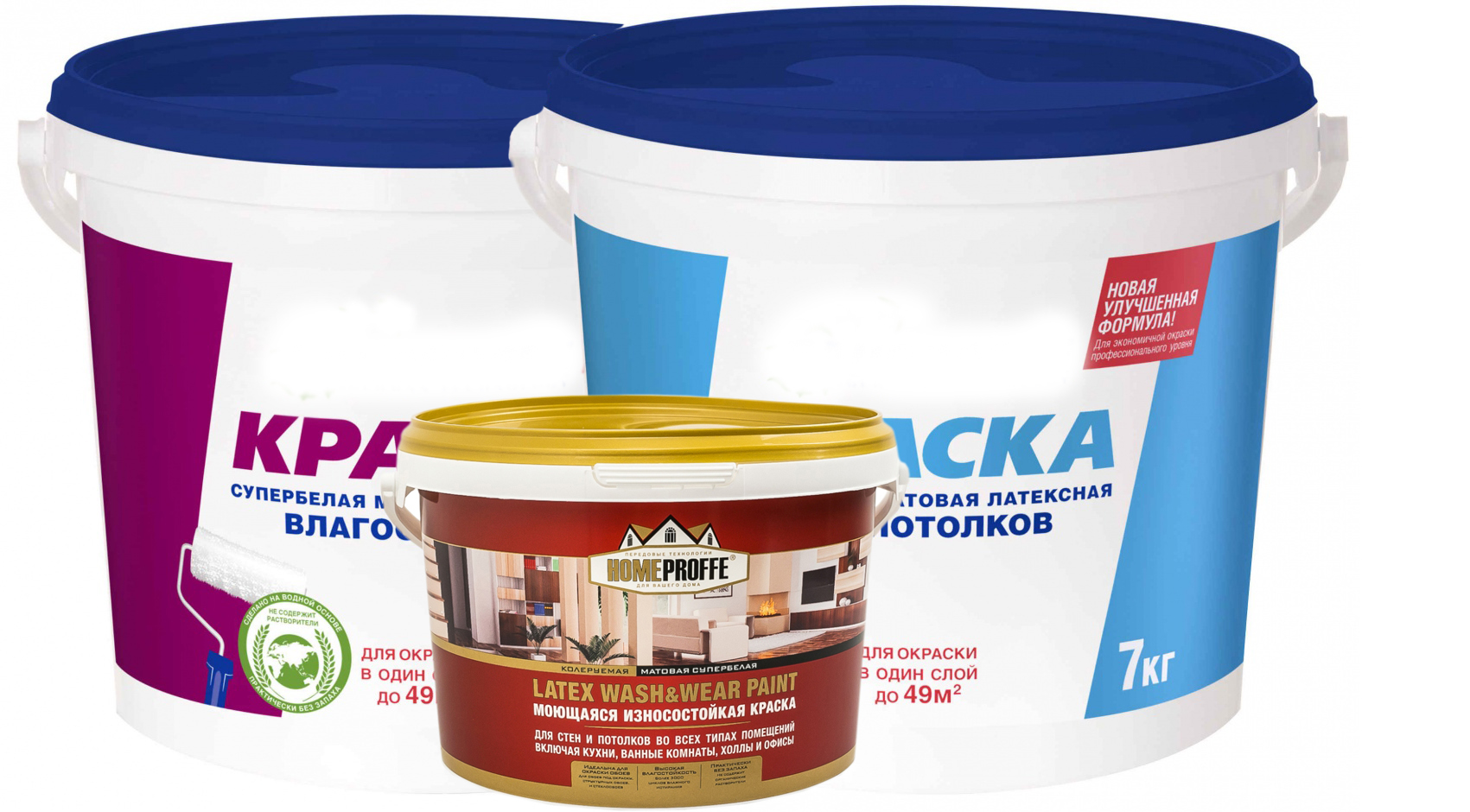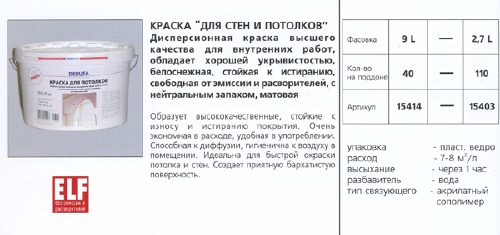Calculation of the amount of paint
On the paint label, manufacturers indicate the recommended consumption - the maximum area that can be painted with 1 liter of mixture in 1 layer. High-quality compounds that overlap the light surface are applied in 2 layers, and to cover the contrasting substrate, the number of repeated applications increases to 3-4. Porous wall materials are capable of absorbing some of the paint, so an additional layer may also be required, as well as for surfaces with irregularities and defects.
When buying paints, the application of which will be accompanied by manual tinting, it is advisable to purchase additional volume for safety net. In this case, it is recommended to mix initially a large amount of the paint coating, since it is almost impossible to achieve an exact shade match again.
Properties
Water-based paint is distinguished by a unique
application technology. From the point of view of the person applying the paint, the process
painting takes place the same, but at the molecular level serious
composition changes. Before application, the paint is water with many
additives mixed in it. These particles are not dissolved in water, but simply stirred.
in it, and being in this state, do not interact with each other.
When applied to a surface,
significant composition change:
- water evaporates, activating particles
paints; - binders converge,
turning into an even uniform layer; - hardeners give the coating
relative stiffness.
Considering that the solvent in similar types
paints are water, no harmful and toxic substances are emitted during evaporation.
The fire hazard of painting works is also minimized.
Another clear advantage is
durability and the ability to apply a new layer directly to the old paint. Front
applying a new layer does not require any special treatment or removal
old paint (provided that the old coating was not oily).
Negative property of water-based emulsion
paint is the effect of corrosion when pure metal comes into contact with water. But
a number of manufacturers, using modern additives, have established the production of paint,
minimizing such consequences.
Composition
The exact composition will vary depending on
paint manufacturer and its purpose, and, as a rule, is kept by the company in
secret. But, without going into the smallest details, it can be argued that any
water-based paint consists of the following components:
- 40-60% water and dissolved in it
film former; - 30-40% fillers and coloring pigments;
- 5-10% plasticizers;
- 5-10% other additives.
To create facade paints, always use
antifreeze designed to withstand freezing temperatures, and acrylic
resins to give elasticity to the finished paint layer. Also apply
ultraviolet and infrared filters to prevent damage,
caused by solar activity. Waterproof
paint is obtained by adding synthetic rubber to the composition or
analogs.
Shelf life
The shelf life directly depends on the storage conditions.
Manufacturers guarantee the complete safety of the product for at least 6
months, the same period is fixed by the current GOST. The paint should be stored in
sealed original packaging without exposure to sunlight.
The storage temperature is strictly positive, from +5 to + 30 ° С. Allowed
transposition at low temperatures, but not more than 1 month.
In fact, the paint is stored at least twice
longer, and some manufacturers still indicate on the packaging a period of 12
months. After this period, the paint will begin to lose its properties, but for local
works, many also use 2-year-old remnants of already open paint. Requirements
it is better to observe the temperature regime, because a significant part of the paint is water,
which can turn into ice.
Viscosity in DIN
According to the current GOST, the viscosity
water-based paints is at least 30din. Overwhelming
most manufacturers supply paint with a viscosity of 50-60 and more, for
subsequent dilution with a solvent. Measurements must be carried out at
paint and ambient temperature within 18-22 ° С, otherwise indicators
will not be true.
Depending on the method of applying the paint,
the optimal viscosity of the composition will also change:
- 20-25 when using
spray gun; - 30-40 for roller
- 40-50 for a brush.
When diluted with water-based paint with water
it is recommended to use only distilled water. Plain water from
under the tap or the nearest body of water is not suitable because of the contained in its composition
various impurities. When applying paint with similar water to the surface, after
evaporation of water will leave white marks and streaks.
Preparing paint
Dilution of paint
The paint in the can has a thick consistency. Undiluted composition is great for creating relief compositions, but too thick for normal painting. In this regard, the emulsion is first thoroughly stirred, and then water is added to it. The quantity is determined based on the recommendations of the manufacturer or empirically. Water is added until the paintwork material acquires the desired consistency. Correctly diluted paint resembles fat milk in density.
If you plan to use a spray gun, tap water will not work, because after the coating dries, a whitish coating forms on it. In this regard, distilled water or alcohol is used for dilution.
The paint must be thinned just before use. Already after 15-20 minutes, the composition thickens. If this time is missed, the paint should be thinned again.
Tinting
The water-based composition is available in white. If you want to give the paint a different color, add pigment to it. This can be done at home or right in the store, if there is specialized equipment there.
If you are tinting yourself, it is recommended to purchase a pigment with a margin of 10-15%. This will allow you to recreate the composition for updating the coverage in the future without problems.
The color is added gradually, after which the solution is thoroughly mixed. If the intensity of the shade obtained does not suit you, then you need to add more pigmenting agent.
First, you should dilute a little tinted paint, which will allow you to see how it will look on the painted surface. Moreover, the shade of the dried coating differs from the color of liquid paintwork. You also need to keep in mind that paint with a broken period of use or improperly stored can have a significantly changed color (in comparison with the original) and poorly adhere to the surface. Poor quality paint forms a bubble coating or simply drips off the surface completely.
Paint consumption
The approximate consumption per m2 is indicated by the manufacturing company on the bank. Based on these data, it becomes possible to plan the consumption of paintwork materials.
You can also calculate the amount of paint you need, based on the General consumption rates of water-based paints and varnishes:
However, it should be remembered that the consumption rates of 1m2 of the same paint can vary greatly depending on additional factors. In particular, we are talking about the type of material to be painted. A smooth surface absorbs 15-20% less paintwork materials in comparison with a rough one.
Note! The calculations take into account the number of layers. Most often, one layer is not enough to paint the surface - they will need at least 2-3
Also, the used tool affects the material consumption. For example, the use of a spray gun allows you to reduce the consumption of paintwork materials, but only if the painting is carried out in calm weather.
The flow rate also depends on the temperature and humidity of the air. In hot weather, the liquid quickly evaporates from the dye, and therefore the coating is formed unevenly - you have to reapply the layers. Additional losses of paintwork materials are a common occurrence when painting the ceiling, since the composition simply flows down.
Instruments
To apply paint, use brushes, rollers or spray guns. Brushes are best for small surfaces with many angles and raised details. A spray gun is a convenient tool, but not everyone has it available, and buying it for one painting is not always advisable. Therefore, a roller is most often the best for surface painting.
There are several types of rollers:
- Foam rubber. They are distinguished by their low cost. Too much dye is taken up, and therefore bubbles and irregularities form on the coating.
- Velor. It is more difficult to buy them due to their lower prevalence. Velor rollers are characterized by low absorbency. This property has a positive effect on the quality of the painting, but the roller will have to be dipped very often.
- Hairy. The best option for painting. On sale there are rollers with different pile lengths (affects the layer thickness). The most expensive fleecy rollers are made of felt and fur. Also a good choice is polyamide fiber rollers.
Features of the compositions
Choosing paints and varnishes for the repair of premises, you should know that they can differ in their characteristics, have a different composition, from different manufacturers. Some types of materials can only be used indoors, others are used both inside and for painting walls outside.
The basis of the water-based paint is water, to which mineral components are added. After the water dries, a strong film forms, which protects the surface from external negative influences and makes the walls and ceiling attractive.

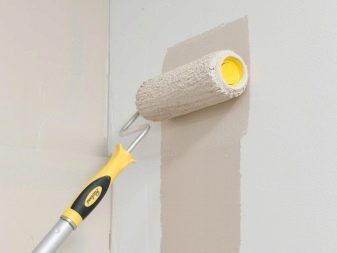
The final result depends on what kind of paint you use. There are such types of paints and varnishes that differ in components:
- Mineral paint. It is made by adding lime or cement to the composition. It is inexpensive, easy to apply, but quickly begins to fade under the sun's rays and is easily damaged.
- Silicate - it is produced using liquid glass. Such paint can be used to paint a room inside and outside, since the material is resistant to sunlight, increased water resistance. Having painted the walls with such paint, you can forget about repairs for 10 years, the material will retain its color.
- Acrylic paints. They are recommended to be used in a dry room; for greater moisture resistance, latex is added to the material. After applying this material, a flat, smooth surface is obtained; in the process, minor cracks on the walls are tightened.

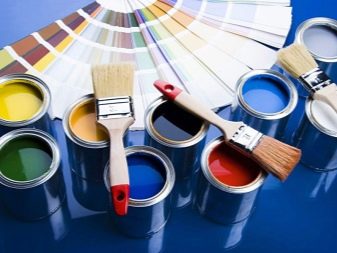
- Using silicone paint, you can fight cracks on larger walls, up to 2 mm. The material is quite expensive, but it has many advantages: the paint lies flat on the surface, passes water vapor, and retains its qualities for a long time.
- For renovation work, you can use polyvinyl acetate paints, which have many advantages. They are used for finishing porous materials such as wood, cardboard, plaster. The material dries quickly, has no ingredients harmful to health, adheres well to the surface, after drying, an excellent result is obtained.

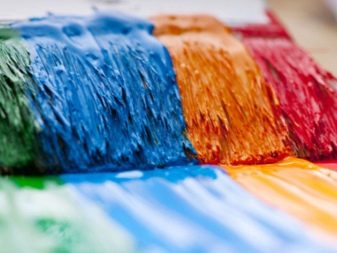
The main types of water-dispersed paints by bases and their characteristics
The developers annually offer dispersions with new inclusions and binders. Relatively new proposals include some decorative emulsion and water dispersion paints that form an unusual texture, for example, imitating a stone. They can be applied to any primed substrate, including wood and metal.
Modern water-based enamels are classified by type of application:
- Facade;
- Interior.
They contain common components, for example, to protect against mold and mildew, all differ in composition and characteristic properties. There are also latex and hammer formulations with a special effect.
The developers annually offer dispersions with new inclusions and binders.
Polyvinyl acetate
PVA-based paints are characterized by low hydrophobicity, so they should not be used in a damp room. They are suitable for painting plastered ceilings in an apartment with a stable temperature regime. This is a budget option for redecoration.
They are suitable for painting plastered ceilings in an apartment with a stable temperature regime.
Acrylate
Dispersion paint with the addition of acrylates remains the most demanded, due to the optimal ratio of price and quality. It is resistant to UV rays, therefore it is recommended as an interior design, even on the south side. A vapor-permeable elastic coating is also guaranteed.
The water-resistant composition is easy to use, the layer does not crack even with a noticeable temperature difference. But this does not mean that you can experiment as facade coatings, if the packaging says “for interior work”. The advantage is a perfectly flat surface after painting, regardless of the base material.
The water-resistant composition is easy to use, the layer does not crack even with a noticeable temperature drop.
Latex or styrene-butadiene
Styrene-butadiene dispersed compositions are moisture-resistant, but their pigment quickly burns out under the influence of sunlight. The interior is the place. These are latex formulations based on synthetic and organic resins such as rubber that look great after drying.
Application - toilets, bathrooms and showers, as they perfectly resist moisture and wash well. It is possible to paint insulated attics, cellars and wine cellars. The walls of glazed loggias and balconies are quite acceptable, provided that a dull shade is used (the polymer quickly burns out in the sun).
Application - toilets, bathrooms and showers, as they perfectly resist dampness and wash well.
Silicone
If we talk about what silicone water-dispersion paint means, then it is worth focusing on its specialization. It is known to specialists as a façade dye of excellent quality. These mixtures are distinguished by the property of repelling dirt and water, cleansing the wall during rains. Therefore, the building by the road will remain clean even in bad weather.
The coating will protect the walls from any impact, while maintaining high aesthetics and uniformity of processing. With this composition, specialists work on basement and facade surfaces - on brick, concrete and plaster. It is noteworthy that matte and glossy variations are offered for facade work.
The coating will protect the walls from any impact, while maintaining high aesthetics and uniformity of processing.
Dispersion-silicate
Silicate dyes are also water-based. Liquid glass and sodium ethyl silicate in its composition explain their name and classification - mineral paints. Main varieties:
- Dispersed silicate (acrylic added);
- Silicate silicone.
The basic requirements for compositions and their properties are regulated by GOST.
Silicate dyes are also water-based.
Specifications
To describe the water-based composition, the following factors are important:
- Paint components. An aqueous solution can contain a variety of fillers, thickeners, antiseptic agents. Depending on the composition, the paint is intended for facade or interior work, wet or dry rooms, etc.
- Scope of use. The composition can be universal or for painting only one type of surface (for example, wood).
- Consumption of paint and varnish composition. Calculate the amount of paint in milliliters based on how much it will take to cover 1 square meter in one layer. In doing so, many factors are taken into account, including the type of material and the condition of the surface.
- Specific gravity. High-quality water-based paint has a density of approximately 1.5 kg per 1 liter.
- Viscosity. This parameter indicates the degree of dilution with liquid.
- Humidity of the environment during application and use.
- Drying time.
- Storage conditions.
- Shelf life.
- The service life of the coating.
There are other technical details to be aware of, including the proportions of paint components and common markings.
Note! Water-based paint is always white, and color is obtained by adding a special pigment
Component proportions
An important component of water-based paints is an emulsifier responsible for film formation.
The following components are used as film-forming agents:
- styrene butadiene;
- acrylic resin;
- polyvinyl acetate;
- styrene acrylate.
Also, mica, barite, talc, chalk are added to the composition. The proportions in which these or those components are contained in the paint are determined by its purpose.
The thickener function is performed by a complex compound - carboxymethyl cellulose. In everyday life, this component is called the adhesive composition of the CMC.
Note! It is recommended to use a spray gun for working with emulsion paint. Spraying allows for the best quality and most uniform coverage
The table shows the ratio of the various constituents in water-based paint:
Water-based paint and varnish material is made by adding a white pigment, for example, zinc oxide or titanium dioxide.
According to the main component, all water-based dyes are divided into several types:
- silicate;
- acrylic;
- silicone;
- mineral.
Marking
On the paint can or in the accompanying documents, abbreviated letters and numbers are used. At the beginning there are letters suggesting the type of composition:
- VE - water-based paint;
- VD - water-dispersive.
The following letters indicate the type of polymer used:
- CS (styrene-butadiene);
- VA (polyvinyl acetate);
- AK (acrylate or styrene acrylate);
- VS (polyvinyl alcohol).
In addition to letters, numbers are used:
- 1 - compositions especially resistant to atmospheric phenomena;
- 2 - paints for interior work.
Note! Requirements for water-based paintwork materials are set out in GOST 281960-89. Unlike GOST, the TU rules are much less stringent, and therefore the quality of products manufactured according to TU cannot be guaranteed
Advantages and disadvantages
Water-based paints have many positive qualities:
- Good adhesion to various types of materials.
- Easy to dilute in water.
- Environmental Safety.
- Fast drying.
- Lack of unpleasant odor in the room after painting the surface.
- Strength. The coating does not flake off.
- Resistant to chemicals, including alkalis.
- Easy to remove dirt from the coating.
- Fire safety.
- High water resistance of certain modifications, which makes it possible to paint surfaces with such compositions in bathrooms and kitchens.
- Antibacterial properties.
- Long service life of the coating, reaching 18-20 years.
- The ability to mask surface defects (with the proper level of viscosity of the composition).
- Compatibility with all types of interiors. Thanks to tinting, the paint has the widest palette of colors.
- Low cost.
Water-dispersed paints also have disadvantages:
- Sensitivity to temperature when staining. The minimum threshold is 5 degrees above zero.
- Certain types of paints form surfaces that are not very durable.
- Not all water based compounds are suitable for metal substrates or glossy surfaces.
Varieties and specifications
Common to all water-based paints is
water base and emulsion type of coloring pigment. Distinguish paints by
binder composition that provides the desired performance for
specific application. The most common types of water-based
paints are:
- acrylic;
- silicone;
- silicate;
- mineral;
- latex.
The paint consists of purified water carrying
the role of a solvent, a coloring filler containing one of the above
bases, as well as various plasticizers and additives.
In addition to the binder, the main distinguishing
characteristics of paints are:
- water permeability;
- density;
- application area.
For quick drying of the paint after application,
use special hardeners. Depending on the expected conditions
work, thickeners or additives based on antifreeze are added to the composition.
VEAK
VEAK 1180 paint is one of the most
common varieties of water-based paints. This type of paint
produced in accordance with GOST 28196-89, according to the requirements of which, all products
meets the following characteristics:
| Density | 1.4 g / cm |
| Viscosity | From 30 s / m |
| Drying time | 1 hour |
| Abrasion resistance | 3.5 μm / kg |
|
Mass fraction of non-volatile connections |
53%-59% |
| PH | 6,8-8,2 |
It is an acrylic based paint used
for interior finishing works. All paint of this type is exceptionally white, but, due to the possibility of tinting, it can
acquire any color and shade.
Water-based acrylic
Acrylic based paints are versatile,
and include a whole group of varieties, classified according to OKPD 2 number 20.30.11.120. This paint is used
indoors and in the production of facade work. At the same time, the acrylic base
is the most expensive of water-based paints.
Acrylic paint is very durable, lifespan
ranges from 5 to 20 years. The paint is applied to almost any surface,
evenly distributed over the plane. Once dry, the paint creates a fairly
dense layer, poorly permeable to air and other substances. Also strong
the advantage of this base is considered to be high frost resistance and resistance to
temperature drops.
Latex
Latex paint contains
rubber that gives elasticity to the applied layer. This kind also applies as
inside and outside the premises. There are different types of paint, and it is not divided
only according to the field of application, but also according to the characteristics of the finished surface with
gloss point of view. Distinguish:
- CM is completely matte;
- M matte;
- MP is half matte;
- PG is half glossy;
- G glossy;
- SG is completely glossy.
This type of paint is used to create
volumetric texture of the painted surface. Like acrylic paint, latex
calmly transfers contact with water after the surface is completely dry.
For concrete for outdoor use
Majority
water-based paints for outdoor use are created on the basis of acrylic, latex
or silicate, including for concrete work.
Such coatings are not only decorative, but also protect concrete from
moisture and ultraviolet radiation.
The paint lays down in a dense layer and fills everything
small irregularities in the surface, forming an even, uniform layer. Facade paint
for concrete must have the following characteristics:
- high adhesion rate, then
there is "sticking" to the surface; - strong moisture resistance;
- high abrasion;
- UV resistance;
- vapor permeability, for the possibility
evaporation of water and other substances from concrete; - high resistance to dirt.
For outdoor woodwork
For these types of work, paint requirements
will be even tougher, because wood, unlike concrete, is subject to decay. If
use paint that is permeable or even more absorbing water, then the surface
will quickly become unusable, and this will affect not only the appearance, but also
strength in the structure as a whole.
The general characteristics of the paints will be the same
as for concrete, but paints specially formulated for wood are easier to apply and will hold better. Today
there are water-based coatings with antifungal additives that allow
create additional protection.
Painting with polyvinyl acetate water-based emulsion compositions
Painting of ceiling and wall surfaces with polyvinyl acetate water-based emulsion is performed in the following order:
- Check the alignment of the paint with the surface to be treated.
- The working area is cleaned of dust and dirt.
- They clean off the old plaster, check the strength of the old filling of cracks and seams.
- They pass along cracks and grooves with putty. Allow to dry. Peel off with skinning.
- Whitewashed surfaces are washed off to the base with soapy water. Allow to dry. Cracks close up.
- At a low temperature, the container with paint is heated to room temperature.
- Open the container with the dye, remove the dried film, mix the contents until smooth.
- Depending on the method of application: by brush or spray gun, dilute with the volume of water indicated on the label. Stir until smooth.
- For tinting, a part of the dye is cast, a dye is added to the container, a volume is prepared by 10-15% more than planned. In case of overspending, picking up a shade is not easy. It is better to immediately prepare an excess volume of the colored solution.
- To save paint consumption, prime the work area with a primer mixture.
- Apply the prepared composition to the surface.
The video tutorial will help you paint the walls with polyvinyl acetate water-based paint professionally:
Today it is difficult to imagine repairs without the use of paints and varnishes. At the same time, it received particular popularity water-based paint
, which is suitable for outdoor facades and interior works. The composition fits perfectly on any type of surface: wood and brick, concrete, plaster, etc.
Reasons to buy water-based paint
There are many reasons that make water based paint so popular. We are talking about its high technical and operational characteristics:
- ease of use;
- fast drying;
- lack of unpleasant odor;
- high hiding power;
- profitability;
- fire safety;
- ecological cleanliness and hygiene.
Water-based paint forms a waterproof film on the surface, preventing moisture from seeping inside. At the same time, the material retains the ability to "breathe".
Water Based Paint: Where Used
Before buy water-based paint
, it is necessary to determine the type of surface to be painted. Thus, latex-based formulations are suitable for application to textured wallpaper, plaster or cement. But acrylic acid is considered universal.
In some cases, water-based paint is enriched with special additives (including antiseptic). This increases its durability and provides additional protection for the coating.
Today the company "LeaderGroup Stroy" offers its customers a wide range of paints and varnishes. You can buy water-based paint of the required color from us. We guarantee high quality of all goods, as well as their prompt delivery and reasonable prices.
Polyvinyl acetate paint is used for interior and exterior decoration of residential and industrial premises. It is designed to work with plastered, concrete, plaster and wood surfaces. Also adheres well to the layer. For painting, you can use a brush, roller or spray gun.
Material features
Before buying, you need to study some of the main indicators of this composition:
- Viscosity is a characteristic of a substance, which is determined by the degree of concentration of water in the paint. The indicator is measured with a viscometer. For use with a roller or brush, the viscosity should be 40–45 Art. If the composition is applied by means of a spray gun, then no more than 25 Art.
- As for the expense, it cannot be said unequivocally. The average is 180 ml per square meter. But this amount may vary depending on the characteristics of the surface to be treated, the tools used and the quality of the paint. The specific gravity of the material is 1.4 kg / l.
- Drying time ranges from 2 hours to a day. This difference is explained by the fact that in humid rooms and without proper ventilation, water evaporates less intensively. The recommended operating temperature is 20 degrees Celsius, and the air humidity is 70%.
- The shelf life of water-based paints is limited to 24 months from the date of production. Once opened, the paint should be stored in a cool, dark place and not allowed to freeze.
Correct application
Correct observance of a certain order in the performance of work is the key to success. This must be observed when painting:
- first you need to make a choice of a certain type of paintwork (it all depends on the conditions of application and operation);
- then preparatory work will be required: removal of dust and whitewashing, leveling and elimination of cracks;
- primer;
- preparation of paintwork materials;
- applying paintwork materials to the surface;
- when applying the second layer, it is necessary to wait until the first layer is completely dry to reveal non-staining and other defects.
Thus, polyvinyl acetate water-based paint is not a universal finishing material. However, the range of her work is quite wide. The price of these compositions is pleasing to the eye, given the high quality and constant compliance with GOST. Thanks to such paint, everyone can do the repair, not just a professional painter.
In the following video, you will learn the secrets of the perfect preparation of walls for painting.
Paint application
The prepared paintwork material is poured into a paint tray. To make it easier to paint, reaching the most remote areas, a long handle is attached to the roller. In this capacity, a plastic tube or a light wooden holder is used.
Apply paint from the corner of the wall. Moreover, it is painted over with a brush. Then they dip the roller into the paint, squeeze it on the pallet and make movements down and then up. The thickness of the applied strip is equal to the width of the roller. Each next strip is applied with an overlap with the previous one. In this way, the appearance of visible borders between the stripes is avoided. You need to paint quickly in order to have time to develop the entire diluted paintwork material.
2-3 layers of water-based composition are applied to the plastered walls. Each time they wait for the coating to dry before starting to apply a new layer. The average break is 3-4 hours.
Note! When applying paint to the wallpaper, one layer is enough
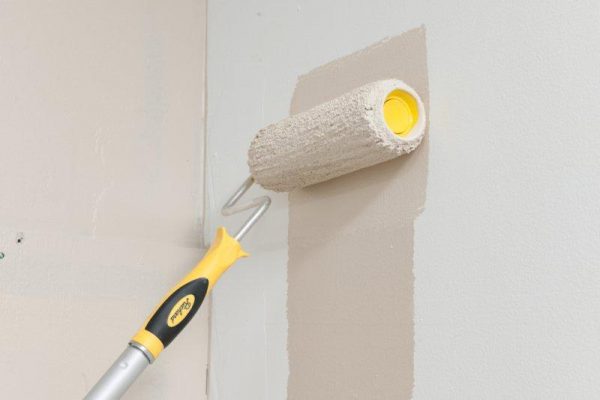
Decorative painting
If you wish, you can not just paint the wall or ceiling, but draw a picture or patterns. To do this, you need a curly roller, a stencil and masking tape.
Note! Decorative painting is carried out after the base coat has dried. They work with a curly roller in the same way as with a regular one.
There is a wide variety of patterns and textures, for the selection of which it is enough to change the stencil. You can buy it in the store or make it yourself. An instruction is attached to the purchased stencil, which indicates the colors for all its segments.
They work with a curly roller in the same way as with a regular one. There is a wide variety of patterns and textures, for the selection of which it is enough to change the stencil. You can buy it in the store or make it yourself. An instruction is attached to the purchased stencil, which indicates the colors for all its segments.
Advice! When using a stencil, do not press it too much against the surface, as this will result in drips.
Masking tape is needed to create geometric patterns. It closes that section of the wall that currently does not need to be painted. Then the tape is removed and a layer of paint is applied to the vacated surface. Thanks to the scotch tape, it is possible to avoid paint on unwanted places. Remove it only after the paint layer has dried to prevent drips.


